#austerity photo club
Text

"4, 3, 2, 1", de Paul Auster, "El poder del ahora", Eckhart Tolle y "En breve cárcel", de Silvia Molloy en la #LíneaA
#paul auster#sylvia molloy#el poder del ahora#eckhart tolle#auster#4321#poesia#escritoras#lectoras#subte#girls reading#women reading#currently reading#amo leer#leo y comparto#leo y reseño#booktok#booktoker#bookgram#bookgasm#bookriot#bookpic#bookpost#bookphoto#book photo#book advice#libros#book aesthetic#bookclub#book club
5 notes
·
View notes
Text
1958 - Brian May takes up a scholarship at Hampton Grammar School. It's described as strict and austere, with high standards and an emphasis on academic achievement. Brian joins the drama club, the school choir, and the debating society. (Source: Queen - The Early Years)
Roger was not the only choir boy.
These photos, however, are from 1961/62.


21 notes
·
View notes
Text


MARDI 17 AOÛT 2024 (Billet 1 / 3)
Nous allons sûrement retourner à Grégolimano (Grèce – Île d’Eubée) l’année prochaine et ce pour de nombreuses raisons. Mais la principale, c’est le logement que nous choisissons. En effet dans ce Village du Club Med on nous a dit qu’il y en avait 17 sortes différentes. Le Village est très étendu (heureusement car il peut accueillir un peu plus de 1000 personnes en pleine saison), comprenant un hôtel qui lui-même est divisé en 3 parties, à côté duquel, à droite et gauche, sont disséminés des petits bâtiments dans la pinède, abritant plusieurs chambres, au rez de chaussée et à l’étage.
Quand on tourne dos à la mer, sur la gauche, le long de la plage, il y a 17 bungalows. C’est dans l’un d’entre eux, le même, que cette année nous avons été logés pour la 3e fois. L’immense privilège de ces bungalows, c’est qu’ils sont quasiment les pieds dans l’eau.
Sur la première photo, la petite flèche rouge indique la situation du nôtre et la seconde, son entrée principale, côté pelouse.
Ces quelques lignes servent d’introduction à un compte-rendu de lecture d’un livre que JM a dévoré avec délice sur la plage. Un peu de patience, nous y venons…
Ci-dessous, pardon, la photo a été prise au petit matin et le lit n’a pas encore été fait. Mais, juste derrière la baie vitrée il y a une petite terrasse avec 2 transats et quelques marches sur la droite pour descendre sur la plage. A 2 pas, les 3 transats que nous réservions pour la journée… et 2 pas plus loin, LA MER !!!




En dehors de nos baignades, notre principale activité sur la plage a été de tourner les pages des livres que nous avions emportés. Marina a d’abord terminé le livre de Pierre Bailly « Le roman de Jim » qu’elle a beaucoup aimé (et préféré au film qui en a été tiré, même si ce dernier ne l’a pas laissée indifférente), puis s’est plongée dans le dernier ouvrage de Melissa Da Costa « Rester debout » qu’elle a fini à Paris. Une histoire très dure mais qui l’a passionnée. Elle devrait écrire un petit Billet prochainement à son sujet.
JM, quant à lui, a terminé le gros livre de Siri Hustvedt, la femme de Paul Auster, « Tout ce que j’aimais ». Marina l’avait bien aimé, JM, même s’il a trouvé l’histoire intéressante, n’a pas été tout à fait emballé tout en reconnaissant le talent de l’auteure.
Et nous arrivons au thème de ce Billet : vous dire LE PLUS GRAND BIEN du livre qu’il a lu ensuite, « MES NUITS SANS BARDOT » de Simonetta Greggio (écrit en français – Albin Michel – 320 p.)
LA 4e DE COUVERTURE :
« On a cru me connaître parce qu'on m'a vue nue. Mais personne ne sait qui je suis vraiment. »
Une femme s'installe à Saint-Tropez, tout près de La Madrague, afin de percer les mystères qui entourent la star flamboyante et secrète. Leurs voix, leurs histoires se répondent, mettant en lumière les multiples facettes de Bardot - de la fillette disgracieuse à l'amoureuse passionnée en passant par l'adolescente perdue et la militante de la cause animale -, et font ressurgir du passé de grandes figures artistiques : Colette, Vadim, Brando, Trintignant, Yourcenar et Gainsbourg...
À travers un troublant jeu de miroirs, se recrée sous nos yeux le mythe BB, un être d'une stupéfiante modernité.
L’AVIS D’UN LECTEUR (trouvé sur le site Babelio et en parfaite adéquation avec ce que JM en a pensé) :
Enfin un roman captivant que je n'ai pas lâché durant 3 jours !!!
Ça faisait longtemps que je n'avais pas été passionné à ce point par un bouquin !
Je dois dire que celui-ci est une vraie pépite !
J'ai été addict à l'écriture de l'autrice et au déroulement de l'histoire, qui n'est pas une biographie, mais où l'on apprend tout de même beaucoup de choses sur BB.
C'est truffé d'anecdotes croustillantes de la star internationale, depuis ses débuts dans « Et Dieu... créa la femme » en passant par des navets dans lesquels elle a joué, tout en parcourant ses histoires d'amours sulfureuses avec Roger Vadim, Jean-Louis Trintignant, Jacques Charrier, Samy Frey, Serge Gainsbourg, Gunther Sachs et tant d'autres... pour arriver jusqu'à son parcours de militante pour la cause animale.
L'auteure a planté le décor en imaginant une femme qui vient séjourner à Saint-Tropez, tout près de la Madrague où vit Brigitte Bardot, afin de percer les mystères autour de la star.
Cette femme, visiblement fan de BB, garde malgré tout quelques réserves sur certains sujets non gratifiants de l'actrice. Elle va commencer un dialogue épistolaire à sens unique, en laissant des petits mots et des lettres sous un caillou à l'entrée de la Madrague, afin que Brigitte Bardot puisse les lire et lui répondre. Elle sera dans l'attente de réponse de la part de BB durant des jours et des nuits entières, d'où le titre du roman.
Je ne veux pas en dévoiler plus, car il y a tant de choses à dire, mais j'ai réellement aimé ce roman, qui je le rappelle encore une fois, n'est pas une biographie mais bien une fiction. Cependant, certains passages sont extraits des deux autobiographies de BB, ainsi que d'archives et de différents documentaires.
Comme Marylin Monroe, Brigitte Bardot fascine, intrigue, dérange parfois...
D'ailleurs, quelque part, c'est un peu la Marylin française (il y a un passage de leur rencontre à toutes les deux à Buckingam chez la Reine d'Angleterre qui vaut le détour).
Jamais quelqu'un n'aura déchaîné autant de passion, d'adoration, de haine. « Mes nuits sans Bardot » de Simonetta Greggio, plein d'humour et d'affection, fort bien documenté, très bien écrit (un peu façon « Sagan première époque »), est très agréable à lire, je vous en conseille vivement la lecture !
Le Prix :
Les jurés du Prix du Livre de Plage des Sables-d’Olonne, présidé par Jean-Christophe Rufin de l'Académie française, ont choisi pour sa 4e édition de récompenser la romancière italienne écrivant en français, qui imagine la vie recluse de l’actrice du « Mépris ».

Et après les plaisirs de la lecture (« La lecture, ce vice impuni », une citation de Stéphane Olry), de longs moments passés dans l’eau puis la « communion » avec le soleil (mais point trop n'en faut, juste le temps de sécher les maillots…).






2 notes
·
View notes
Text









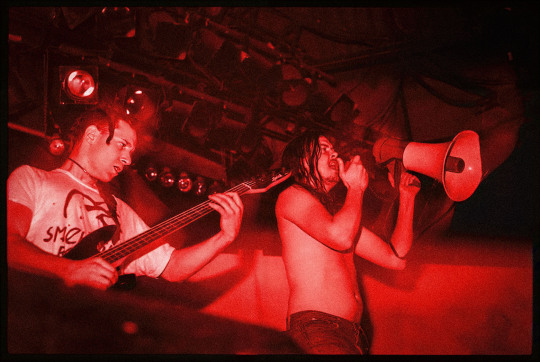

BUTTHOLE SURFERS, TORONTO, 1987
One of the highlights of 2019 was the publication of What Does Regret Mean? - a thick coffee table book about the career of the Butthole Surfers, published by Melodic Virtue. It wasn't just that such a thing existed, but also that it contained two double-page spreads from my 1987 portrait shoot with the band when they came through Toronto to play RPM, a big dance club on the waterfront here (long since demolished). If you were around when the Buttholes were releasing their first records, the thought that they might have had the longevity or mainstream appeal necessary for such a souvenir record of their work would have been inconceivable. But here it is, in multiple hardcover and softcover editions.
Like almost everything I shot back then, the Butthole Surfers shoot was a fluke. I went down hoping to get a group photo, and discovered that the band were even more difficult to corral than their reputation had suggested. I got a handful of sloppy group shots and then pivoted to asking them to line up for individual portraits. I had to move fast, and shifted my only light - a flash bounced into an umbrella on a portable light stand - a few feet away from the back wall of the club and invited lead singer Gibby Haynes to be the first sitter. He stepped smartly into the frame and I did a fast light reading. Looking at my camera I realized I had just enough film to take precisely two photos of each band member.
Years later the Buttholes' drummer, Jeffrey "King" Coffey, saw my photos when I posted them on my old blog, and complimented me on being organized enough to not just keep them but find them again and post them online. He also recalled that the band were more likely than not tripping balls when I took these shots. Coffey and Haynes, along with guitarist Paul Leary, drummer Teresa Taylor (aka Teresa Nervosa), bassist Jeff Pinkus and the band's tour dancer Kathleen Lynch (aka Ta-Da the Shit Lady) all presented themselves for my camera and I took a pair of shots each, then packed up my gear to take home before heading back to shoot the show that night.
Shooting austere photos of such an over-the-top band might have looked like a contrary creative choice, but it wasn't. I was merely working at the limits of my competence at the time, which is what inspired me to revisit this shoot using some of the digital technology available to me today. If I could have shot the band in colour I probably would have. (I was frankly too poor and inexperienced to have been so bold nearly forty years ago.) So I've re-scanned these old negatives today and run them through Photoshop's suite of AI photo enhancement and colourizing filters to give them at least a hint of AI unreality that suits this shoot and this band more than most other work I did way back then. Sadly, drummer Teresa Taylor passed away this year after a battle with lung disease.
#butthole surfers#portrait photography#portrait#photography#film photography#old photos#some old pictures i took#punk rock#pre-grunge#musicians#music photography#pentax spotmatic
11 notes
·
View notes
Text
The New Formalist: Edward Durell Stone
“A great building should be universal, not controversial.” -- Edward Durell Stone
New York Times architecture critic Paul Goldberger wrote in his obituary of architect Edward Durell Stone:
Edward Durell Stone's career as an architect was marked by a dramatic reversal of direction. He gave up a position as one of America's leading advocates of the International Style just as that austere modern style was gaining wide public acceptance, and he began instead to evolve a personal style that was lush and highly decorative, the very opposite of the International Style. (1)
This shift would be influenced by a woman, Durell Stone’s second wife, Italian designer Maria Elena Torch. As Durell Stone said, “Maria's fine Italian hand began to show in my attire and my work. Both began to move toward elegance.”
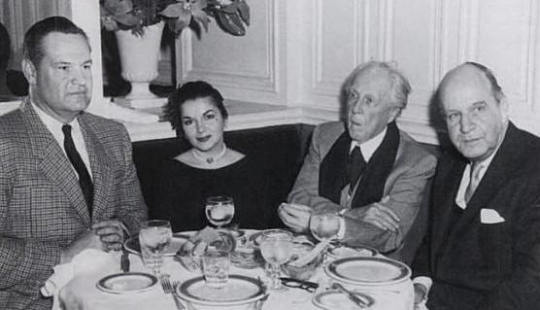
Edward Durell Stone on the right having dinner with (left to right) architect William Wesley Peters, Stone's then-wife Maria Torch Stone, and Frank Lloyd Wright. Photo credit: Charles Rossi.
Edward Durell Stone’s Early Years
Architect Edward Durell Stone was born on March 9, 1902, in the college town of Fayetteville, Arkansas. Durrell’s grandfather Steven K. Stone was a successful businessman, Durrell’s father “Benjamin Hicks Stone (1852-1942) graduated from Emory & Henry College, in Virginia, in 1873 and returned to Fayetteville to run his father's business” (2). In 1885 Benjamin Hicks Stone married Ruth S. Johnson, an English teacher. The couple “had four children, the youngest..., Edward Durell Stone” (2).
Young Edward showed early artistic promise. His mother encouraged him to take up drawing and woodworking. J. William Fulbright was one of Edward’s childhood friends. Fulbright would go on to become a United States Senator. The two men remained life-long friends. Stone attended the University of Arkansas in the early 1920s but was unsuccessful in all of his courses except drawing. His talent came to the attention of the head of the “university's art department, [Elizabeth Galbraith who] recognized Stone's talent and encouraged him” (2).
At that time Edward’s older brother James Hicks Stone was an architect practicing in Boston, MA. Elizabeth Galbraith reached out to the brother asking him “to take an interest in the boy” (2). Edward spent the summer of 1921 in Boston visiting the city’s architectural landmarks with James. The experience made an impression on the young Edward, leading him to his calling. In 1922 Edward moved to Boston and found work as an office boy at the architectural firm of Strickland, Blodgett & Law while he studied at the Boston Architectural Club at night. There Edward met architect Henry R. Shepley who hired him to work as a draftsman at Coolidge, Shepley, Bulfinch and Abbott. Shepley would become Stone’s most valued mentor. (2)

Edward Durell Stone, Radio City Music Hall, Auditorium, (1932), New York City. Image source.
Stone’s Early Architectural Career
“In 1925, Stone won a scholarship to Harvard University's School of Architecture” (2) and also studied at Massachusetts Institute of Technology. In 1927 Stone won the Rotch Travelling Fellowship which gave him the resources to study in Europe for two years. (1, 2) Stone returned to the United States he moved to New York City, just before the start of the Great Depression in October 1929, where he was hired by, “a consortium of architects designing Rockefeller Center. There he worked on what was to be considered his first major early achievement, the design of the interiors of Radio City Music Hall” (2).
“In December 1930, [Stone] married Sarah Orlean Vandiver (1905-1988), an American tourist he had met and courted in Venice. The couple had two sons, Edward Durell Stone, Jr. (1932-2009), and Robert Vandiver Stone” (2).
Donald Deskey was one of the architects that Stone worked with on the Radio City Music Hall project. This association led to Stone’s ‘first independent commission in 1933, the Mandel House, in Bedford Hills, New York, built for owners of a prominent department store” (2). Deskey served as the interior designer on that project. (2) “The Ulrich Kowalski House, also in Mt. Kisco” (4) was built the following year. With the success of the Mandel and Kowalski Houses, many more commissions followed, and in 1936 (3) Stone established his architectural firm at Rockefeller Center (2).

Edward Durell Stone, Richard M. Mandel House (1935), Bedford Hills, New York. Image source.
Stone and The Museum of Modern Art
From 1936 to 1939 Edward Durell Stone worked on what Newsweek magazine called, "the first large museum in America to be built according to the streamlined, ultra-modern 'international' style of modern architecture."(5) The project was the Museum of Modern Art (MoMA) in New York City. Stone collaborated with Phillip L. Goodwin. Stone served as design architect while Goodwin produced the architectural drawings. (2) During this time Stone was also designing a home in Old Westbury, NY for MoMA president Anson Conger Goodyear. (4)
In 1940 Edward Durell Stone drove across the United States. Traveling to Arizona and Wisconsin, he met with architect Frank Lloyd Wright. Wright’s use of materials and decorative patterning manifests itself in some of Stone’s later work. In San Francisco, Stone appreciated the use of natural materials used in regional architecture. His greatest takeaway from the trip, however, was his disappointment at how extensively Americans had marred the natural landscape. Quoting Durell, “I scarcely encountered a place where land was used wisely and where what has been built is beautiful” (6).
Edward Durell Stone's Service in World War II
As the United States had entered World War II, Edward Durell Stone enlisted in the United States Army Air Forces in the summer of 1942, “and was stationed in Washington, D.C. Stone entered as a captain and was promoted to the rank of major in November 1943. At his instigation, the Army Air Forces established a Planning and Design Section in July 1944” (2).
As chief of this section Stone was responsible for “the master plans for airfields in Alabama, California, Florida, Louisiana, Mississippi, and Texas” (2). He also designed the Continental Air Command headquarters at what is now known as Andrews Air Force Base in Maryland. (2)

Edward Durell Stone, William Thurnauer House (1949), Englewood Heights, New Jersey. Image source.
Stone’s Post-war Work
After the war, Edward Durell Stone reopened his architectural practice. Most of Durell’s commissions during this time were residential. The most notable were the David Stench House (1947) Armonk, NY and the William Thurnauer House in Englewood, New Jersey (1949). (2) Stone’s homes of the late 1940s ‘indicated the increasing influence of Wright — his buildings became lower, more horizontal, and relied more on the use of wood” (1).
His non-residential projects included the 300-room El Panama Hotel in Panama City, Panama, “notable for its pioneering use of cantilevered balconies in the construction of a resort hotel” (7). In 1948 Stone designed Fine Arts Center for the University of Arkansas in his hometown of Fayetteville, AK. The center featured works by Alexander Calder and Gwen Lux, friends of the architect. (2)

Postcard photo of Edward Durell Stone's El Panana Hotel (1946), Panama City, Panama. Image source.
Read part two of The New Formalist: Edward Durell Stone.
References
Goldberger, P., (7 August, 1978). Edward Durell Stone Dead at 76; Designed Major Works Worldwide. https://www.nytimes.com/1978/08/07/archives/edward-durell-stone-dead-at-76-designed-major-works-worldwide-a.html
R. L. Skolmen and H. Stone, Edward Durell Stone: Life. https://www.edwarddurellstone.org/
Smart, G., (2024). Edward Durell Stone, FAIA (1902-1978). https://usmodernist.org/stone.htm
Wkikpedia.com, (7 February, 2014). Edward Durell Stone. https://en.wikipedia.org/wiki/Edward_Durell_Stone
"The Glass-Temple Museum: Modern Art Display Takes Over Own Building in New York," Newsweek (22 May 1939): 32.
Edward Durell Stone, The Evolution of an Architect, (New York: Horizon Press, 1962), 92.
Britannica.com, (n.d),.Edward Durell Stone, American architect. https://www.britannica.com/biography/Edward-Durell-Stone#ref81069
3 notes
·
View notes
Text
18/01/2023 ~ NTS Radio ~ Ryuichi Sakamoto Special ~ Further listening/viewing/reading
For Sakamoto's 70th birthday, his friends, peers and collaborators select 10 of their favourite tracks from his discography.
Featuring selections from Haruomi Hosono, Yukihiro Takahashi, Taeko Onuki, Ryoji Ikeda, Banana Yoshimoto and more!
youtube
Documentary filmed during the recording of Ongaku Zukan (1984)
Notes for further reading on the creation of Ongaku Zukan
youtube
Heartbeat Tour - Japan 1992
youtube
Sakamoto plays Sakamoto
Sakamoto Trio World Tour - 1996 - Japan
One of the first ever concerts to be live-streamed!
youtube
Plankton - 2016
A collaboration between visual artist Shiro Takatani and Sakamoto. Part of an art installation at Kyoto Municipal Museum of Art, showcasing Sardet’s images of microscopic plankton. The photos were paired with a video installation by Takatani and music composed by Sakamoto.
youtube
1995 - Music for Yohji Yamamoto Collection
youtube
youtube
This live performance would then be released as Garden of Shadows and Light - the first collaboration between Ryuichi Sakamoto and David Toop.
"The album’s title takes inspiration from the aesthetics of Japanese gardening. The spatial metaphor this suggests is apt, as listeners can imagine themselves wandering through a subtly changing environment, chancing on beautiful details and admiring them before moving on. We are led through a series of discrete moments, each uniquely shaded, whether by highly amplified small percussive sounds, austere electronic tones, or the mournful tones of Toop’s bass recorder. The course of the music follows a non-teleological drift, in which Sakamoto and Toop seem less concerned with establishing an overarching structure than in allowing each moment the space it needs to develop and breathe.
When Sakamoto eventually turns to the piano’s keyboard in the performance’s second half, the music becomes lushly enveloping as his jaggedly lyrical lines float against a backdrop of prepared guitar and field recordings. The music takes a radical, unexpected turn when Sakamoto picks up an electric guitar, with both players turning up the volume for a passage of distorted roar and shuddering feedback – bracing evidence of the unfettered, exploratory approach shared by these two uncategorisable musicians, beautifully documented here."
youtube
2000 - Lack of Love
L.O.L: Lack Of Love is a life simulation game developed created for Sega Dreamcast. The game was released only in Japan and was never exported to the West but it received a fan translation in 2020.
Sakamoto created the score for the game and he was also the game's scenario writer.
The musical score for L.O.L.: Lack of Love was created by film composer Ryuichi Sakamoto, who was also the game's scenario writer.
"The game's creator, Nishi and Sakamoto met at Club Eden via a mutual friend and, through a series of e-mails, began discussing James Lovelock’s Gaia hypothesis. This theory states that the earth's living organisms function in harmony and respond to ecological changes in order for the planet to sustain life. Nishi explained about the game's message: "We should care for other people, life, the environment and nature. Sakamoto came up with the title. We wanted to question the way in which our lifestyle lacks love"."
Recommended tracks: Artificial Paradise / Decision
youtube
In 1994, Japan Football Association asked Ryuichi Sakamoto to compose the instrumental song - "Japanese Soccer Anthem". The song played at the beginning of Japan Football Association-sponsored events.
youtube
Sakamoto appearing in Madonna's Rain music video!
4 notes
·
View notes
Text
The Vacant Lots—Closure (Fuzz Club)

Photo by Luz Gallardo
CLOSURE by THE VACANT LOTS
The Vacant Lots live very much in a territory that Suicide defined in the late 1970s. Like the eerie post-punk-into-disco pioneers, they are a duo, they live in New York City and, in design terms, they favor an austere, very urban, black-and-white aesthetic. Like Vega and Rev, the Vacant Lots use a lot of synths and drum machines to carve out a sort of desolate hedonism. Theirs is a strobe-lit dance macabre that is cool like frantic, A-list clubbing, but also cool like a new corpse’s skin.
The connection with Suicide is not by chance. The Vacant Lots’ Jared Artaud first got in touch with Alan Vega to share a Suicide cover his band had recorded; Vega liked the cut and they became friends. Vega recorded a split single with Vacant Lots in 2014 and remixed the their “6 a.m.” in 2017. They remained close until Vega’s death in 2016, and Artaud has been involved in curating the Vega Vault of unreleased material.
Still the Vacant Lots—that’s Artaud on guitar and vocals and Brian MacFadyen on electronics, drums and vocals—are in no way a Suicide tribute band. Their latest album Closure echoes a whole string of dance-y, post-punk-into-new wave influences, from New Order to Depeche Mode to the Pet Shop Boys. The album’s opener “Thank You” has more than a whiff of the Human League’s 1982 mega-hit, “Don’t You Want Me Baby?” “Thank You” employs its bouncy synths, its pounding four-four, its razor-sharp handclaps to frame the blasted end of a relationship. It’s a bon bon with the center just starting to rot. “Obsession,” later in the disc, is more of the same, with trumpeting blares of plastic synth and thundering thumps of hyper-real drums.
“Consolation Prize,” one of the singles, runs in a sludgier, more downbeat tempo, with thick, woozy wheezes of synthesizer swelling around funereal vocals. “Red Desert” offers serene respite with trebly keyboards and whisper psychedelic vocals that seem very much influenced by one of the Vacant Lots other guiding influences, Sonic Boom. (Peter Kember mixed and mastered the Vacant Lots’ Departure and mastered Endless Night.)
The hypnotic thump of the dance floor meets the spiral gnosis of psychedelia in “Disintegration,” a song that throws up its hands in euphoric transport, while also shuddering with existential angst. The message is equally celebratory and dire: dance or die…or both.
Jennifer Kelly
#dusted magazine#albumreview#jennifer kelly#the vacant lots#closure#fuzz club#post punk#synth pop#suicide#sonic boom
2 notes
·
View notes
Text
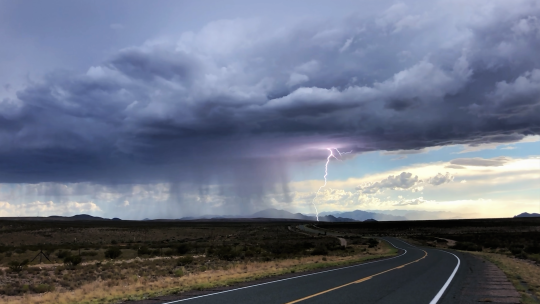
Above: A lightning strike crackles at the edge of a storm cloud above State Route 80 in Arizona.
Sergio Chapa’s photos and a portion of this text also appear in Frontera: A Journey Across the US-Mexico Border and are reprinted with permission from TCU Press. This excerpt originally appeared in the January/February 2024 issue of Texas Observer magazine.
Guadalupe Correa-Cabrera and I met when she was a political science professor at the University of Texas at Brownsville. She was studying drug cartel violence in the war-torn Mexican border state of Tamaulipas, and I was covering the same topic as a journalist for KGBT-TV in the Rio Grande Valley. We bonded over our work—and our mutual desire to “see the entire border.”

We made our first border-to-border journey together in June 2013, stopping at each crossing between Brownsville and El Paso with jaunts into Mexico. And we kept on traveling together for much of the next decade pursuing a dream that became our book, Frontera: A Journey Across the US-Mexico Border (TCU Press, January 2024).
In our first days on the road in June 2013, we’d seen closed businesses and other bleak effects of cartel violence on Mexican border towns, before rolling into Big Bend National Park. We had heard about the park’s beauty but marveled over its mountains, colorful canyons, and unique micro-ecosystems.
While driving along a rocky and mountainous stretch of the park, the Bible verse of Luke 19:40 sprang to mind, “I tell you, if they were to keep silent, the stones would cry out.” The original verse had a distinct meaning, but for us, it meant that if we failed to acknowledge the beauty before our eyes, the rocks themselves might literally protest. After a few minutes, we shrugged it off as maybe stupor over the 90-degree-Fahrenheit day or exhaustion from the eight-hour drive.
But after settling into our hotel in Terlingua, we joined other guests for dinner and live music on a rooftop patio where monsoon rains and lightning strikes could be seen in the distance. A couple of beers later, a solo guitarist sang these lyrics: “And the rocks will cry out.” We looked at each other wide-eyed in that moment of serendipity. After his set ended, we spoke to the musician, who told a story similar to our own.
That night, we sat outside until millions of stars appeared, tracing the Milky Way above us. It was one of what we called momentos mágicos along the frontera.
Despite the negative political rhetoric, the U.S.-Mexico border is a beautiful place, home to welcoming and warm people. It is also a land of contrast—austere landscapes and lush oases; thunderstorms and rainbows; robust industries and ghost towns; great wealth and aching poverty. The residents, known as borderlanders or fronterizos, are among the poorest in the United States. Those in Mexico inhabit cities that can be very unsafe. Nonetheless, these citizens often open their homes and pocketbooks to help stranded tourists as well as asylum seekers from Central America, South America, the Caribbean, Africa, and Asia.

The Fiestas Mexicanas Parade in Matamoros, Tamaulipas draws participants from both sides of the U.S.-Mexico border.
Over the last decade, we have traveled different segments and made three different trips along the whole frontier, from Brownsville, Texas/Matamoros, Tamaulipas, to San Diego, California/Tijuana, Baja California. When we started, we were fronterizos, living and working in the Rio Grande Valley region. We still understand border dynamics, though we’ve both moved; I’m now a freelance writer and energy industry analyst in Houston and Correa-Cabrera teaches at a university in Fairfax, Virginia.
The border region is home to billions of dollars in trade and beautiful landscapes, including beaches, dense subtropical forests, deserts, and mountains. Its sprawling cities offer disparities of their own, with industrial parks and fashionable shopping malls, as well as immaculate country clubs and neglected colonias, where some earn a meager living scavenging recyclable items from landfills.
Its international boundaries were established by wars but people with family, friends, and businesses on both sides have often ignored dividing lines. Far from the capitals of Washington, D.C. and Mexico City, they created their own culture, which is distinct from their parent cultures. The result is a mixture where “Spanglish” has become its own language and where the music, food, binational economy, and resilience of the people reflect this bicultural blend.
Many books have been written about the U.S.-Mexico border, but none is like ours. Frontera offers a glimpse into every crossing community in all U.S.-Mexico border states. It includes notes and reflections by experts, academics and others about the border and about how the pandemic has changed places we visited—and thought we knew so well.
The COVID-19 pandemic and the partial closure of the U.S.-Mexico border transformed the region’s face and socioeconomic configuration. Although we do not know what the borderlands will look like in the future, we do know the border and fronterizos will quickly adapt.
Our last trip to complete this book took place in July 2021.
There was no cloud in the sky on that 100-degree day as we drove Mexico’s Federal Highway 3 between the resort town of Puerto Peñasco, Sonora, and the border city of San Luis Río Colorado.
Neither of us had ever before visited this desolate desert highway along the Gulf of California, but we’d been warned: There is no cell phone service on the remote road, where numerous robberies had taken place and suspects had left victims stranded.
We were traveling in a pack of cars, so things seemed safe at first. I dodged dozens of potholes and drove around dunes slowly creeping over the highway.
We were amazed by views that few Americans ever see: Dunes, crystal blue water, and rugged canyons stretched out beside the highway. The finish line that day was supposed to be dinner with friends in Tijuana.
But then, I couldn’t avoid a deep pothole in time. The impact sent my front passenger side tire flying into sand. Luckily, I was able to stop the car without any other damage. I saw that the side of the tire had split in half. It was unbearably hot and, as predicted, we had no signal.
That’s when an old, beat-up car pulled up behind us. We couldn’t see the driver inside, and suddenly, those warnings flooded back. Panic briefly overcame us until we saw a man get out of the car with his wife and 6-year-old son.
He didn’t waste any time. He had a spare tire, which wasn’t really the right size, but we somehow made it fit. He waited until we were sure the tire would work and refused any money. We made it to Yuma, Arizona where we got a proper-sized tire. We didn’t get that man’s name or number, but he saved our lives. He was our “border angel.”
We are forever grateful to that anonymous and humbleTGood Samaritan, who helped us tell the true story of the border. I still keep the spare tire he gave us in my trunk, ready for the next person who needs it.

Don’t miss another issue, become a member today.
#travel#us mexico border#border#Mexico#Texas#border town#photography#documentary photography#brownsvilletx#matamoros#San Diego#books#tijuana
0 notes
Photo
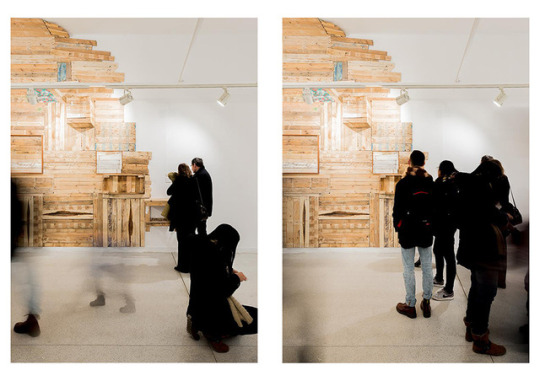
Hasta la vista..
Moltes gràcies a tots i a totes per pasar-vos a veure l'exposició de l'estudi durant tot aquest mes. Ha sigut un plaer poder exposar al CMC, cosa que somiava des de fa uns quans anys. Poc a poc vaig fent camí a travès de les fotos, els fanzines i la fusta. I a tota la gent al meu voltant qui fa de mi qui soc, encara que a voltes tinga les meues coses. Els nous projectes ja comencen des d'ara. I vos dic que vaig a esforçar-me per a seguir treballant com els darrers anys, amb lo justet, però se
1 note
·
View note
Text
the beauty of jyeshta 🐇🏹:

🐇 alexa demie: jyeshta surya
*TW// i do discuss a few triggering topics i.e. abuse and drugs. some of the jyeshta natives i exhibit and talk about are known for terrible behavior and scandals. i do not condone their offensive and ignorant behavior. they are simply being shown to solidify my opinions on the nature of this nakshatra*
as you read this post, please listen to this jyeshta playlist i made for the full experience: https://open.spotify.com/user/a95141rv0vjdg8lqcggilvcxm/playlist/3gzS9sXWs71yb2i9EiBhSY?si=xtP4mnRnR7ahXfN09KwiRw
🏹 they key to unearthing the energies of jyeshta lie in studying it’s associative deities. before we dive down the rabbit hole of the jyeshta nakshatra, let us understand the representative mahavidya of buddha. it is traditionally believed that the tantric goddess tripura sundari is associated with buddha. tripura sundari is also known as the goddess shodashi. the goddess shodashi is said to be the most beautiful in all three worlds. the goddess shodashi is also known as lalita and rajarajeshwari. lalita means “the one who plays” and rajarajeshwari means “queen of queens”. the tantric goddess tripura sundari is a form of mahalakshmi and, therefore, symbolizes wealth and abundance. according to tripura sundari’s dhyana mantra, her complexion radiates with the light of the rising sun. she emanates a rosy color which is representative of her joy, compassion, and illumination.
🌌 tripura sundari is depicted with four arms and holds five arrows of flowers (remember this number for later), a noose, a goad and sugarcane for the use of a bow. her holding a noose represents attachment, the goad represents repulsion, the sugarcane bow represents the mind, and the arrows are the five sense objects. in the sakta tantra, she is depicted as the supreme mother who uses the gods as her instruments of passion. with the aid of the instruments of passion, she presides over the creation, sustainability, and destruction of the universe—the three phases of life. she overlooks the layers of our shadow states, self-concealment and self-revelation, that lie in-between these three phases of life (bhoo, bhuva, and swa). self-concealment is the predisposition to actively conceal from others personal information that one perceives as distressing or negative. self-revelation revelation of one's own thoughts, feelings, and attitudes especially without deliberate intent.
🔥tripura sundari represents the state of awareness that is called “sadasivatattva”. this state of sadasivatattva is said to be based on the belief that “i am this” (aham idam). that, as we evolve through our cosmic destinies, we have an outward flow of consciousness, or pravritti. spiritual practice reverses our state of physical consciousness and cause us to revert to our true being. the action of coming back to our origin and finding attainment within, is a theme of jyeshta’s scorpio rashi itself, the sign of realization. it is the divine understanding that our experiences in this universe lie within the unity of consciousness itself.
🌳many believe that tripura sundari is the beauty that precedes the three worlds. that she is divinity in its infinite meanings, embodying the different aspects of the phenomenal world. tripura sundari is the beauty that we see in the world around us. she is the beauty we find in everywhere we look. modeling the captivating beauty of tripura sundari, jyeshtas naturally are externally perceived as beautiful beings who, solely with their appearances, draw the collective desires of hearts deep within. this is the essence of jyeshta’s features. they enshroud you with an abundance of beauty and over-stimulate your senses to near exhaustion. because jyeshta is symbolized by the jewel or earrings, they adorn their features with jewels and sparkling products to appear otherworldly. most notably, jyeshta natives seem to pay great attention to the forehead, neck, skin, and tongue (as buddha is said to rule these facial features). jyeshtas love to particularly adorn themselves in gold chains (i.e. jyeshta native nicki minaj and her extensive gold chain collection). remember that scorpio is co-ruled by ketu, which is remedied by brihaspati (who is remedied by gold). so the adornment of gold will be very prevalent and calming to these natives.

🐇 fka twigs: jyeshta chandra
👅another interesting characteristic of jyeshta is tongue piercings. because buddha rules the tongue and scorpio rules the blood, we see these natives naturally have quite a great deal of emphasis in their tongue area. they are inclined to/consider piercing their tongues. some examples of this are, willow smith (jyeshta shukra atmakaraka) who infamously got a tongue piercing at eleven-years-old. christina aguilera (jyeshta buddha atmakaraka) had a tongue piercing during her most notably “promiscuous” time frame in her career (aka her “dirrty” years). in the movie “thirteen”, evan rachel wood (jyeshta shani 1H) plays a young girl who gets her tongue pierced as a sign of rebellion. one thing you will notice about these jyeshta natives is that they are always under scrutiny for the changes they make to their body. however, the vimshottari buddha-ruled nakshatras embrace rebellion in the gandanta knot of deadly restriction. after all, mercury was named “the trickster” himself. this correlates back to the trickster archetype of poking out your tongue to make fun of another person. jyeshta natives most frequently pierce their tongues as a clap back to societal standards or parental authority. in this sense, they are quite literally sticking out their tongue for the purpose of mockery. these natives also prefer sticking out their tongues in photography. examine the common photos of jyeshta natives like princess nokia, nicki minaj, and rosalía (jyeshta lagna). you will notice they prefer to playfully stick out their tongue when around others. in the bible, it states “death and life are in the power of the tongue” (proverbs 18:21). meaning the tongue can either be used as a weapon to harm and destroy others or as a tool to build and heal. this is the common unraveling of jyeshta...
♏️ jyeshta lies in the final portion of scorpio. scorpio’s ruling planet is kuja, the mahavidya associated with kuja is bagalamukhi. bagalamukhi is commonly referred to as “the goddess who seizes the tongue”. once, a demon named madan undertook austerities and won the boon of vak siddhi. anything the demon said came to be true. the demon abused this power and killed many people. the gods were enraged by the demon’s wrongdoings, so they began to worship bagalamukhi to invoke her help. baglamukhi stopped the demon by taking hold of his tongue, which was the source of all mischief, and silenced his words. however, she did not kill the demon, because he asked to be worshipped with her and she agreed. this is why the demon is depicted with her. she is repeatedly portrayed with holding the demon’s tongue with a club in her other hand. by stopping the demon's tamasic tongue, she exercised her power over speech and her power to freeze, stun, or paralyze others.
🔪 bagalamukhi is also associated with magical powers, which can sometimes be referred to as siddhis, "accomplishments" or "perfections." among her epithets in her hymn of a thousand names are she who gives the eight siddhis. the invocation written around the edge of an amulet containing her yantra in the tantrasara states: "o bagalamukhi, please arrest the speech of wicked people, paralyze their faces, fix their tongues and destroy their intellect."
⚫️while jyeshtas are fond of displaying and emphasizing their tongues from a physical standpoint, this emphasis does not stop here. as you may have noticed, most of the jyeshtas featured in this thread have gotten into some serious scandals and allegations. for example, jyeshta natives like nicki minaj who married a s*xual abuser/predator, tyra banks (jyeshta surya) and her many blackface scandals, sabrina claudio who has said many offensive racial slurs, brigitte bardot who was known to be heavily racist and abusive to her child, naomi campbell who has been linked to epstein, etc.. their interviews and words are often misconstrued and taken to the extreme, as the public takes every word of their’s as the truth, much like madan (who had the power to speak things into existence). because every word these natives say is treated as the truth, they become either hindered or freed by this power. jyeshta’s have the ability to thrive in the dark abyss of scorpio and yield their words to sway the minds of others.
💎we see the public grasping jyeshtas by the tongue, much like the tantric goddess baglamukhi, and holding on to every word they say. valuing the belief that the powers of life and death lie within the words we speak. once the dark abyss consumes a jyeshta native and they no longer rely on the glamour of the tongue, we truly see how flawed and sorrowful their lives can be (despite their abundant beauty).

🐇 sabrina claudio: jyeshta chandra
💔 jyeshta means “the eldest" or "the elder". she is the goddess of inauspicious happenings and misfortune. as her sanskrit name suggests, she is regarded as the elder sister of lakshmi (the goddess of good fortune and beauty). unfortunately, jyeshta is frequently associated with sinning, laziness, poverty, sorrow, ugliness and the crow. because of her inauspiciousness and crow symbolism, she is sometimes associated with alakshmi. due to jyeshta representing the bad wife and lakshmi representing the good wife, jyeshta is often worshiped for women who wish to keep her away from their homes, as she is said to cause marital disturbances.
🌊 most astrologers agree that jyestha's birth took place during the churning of the cosmic ocean. she was said to be born when the poison, halala, flows from the ocean, while her sister, lakshmi, is born when the elixer of life emerges. symbolic of jyeshta being in the debilitation rashi of chandra, modeling the shadow state of the new moon. whereas, lakshmi is symbolic of the plump, elxir-like full moon that lies in the exaltation rashi of chandra: taurus.
🌀 based on the linga purana, vishnu divided the world into the good and the bad. he created lakshmi and jyestha, both born from the same origin of the cosmic ocean churning. lakshmi marries vishnu, but jyestha is married to the sage dussaha. dussaha soon discovers that his jyeshta (described as his “ugly wife”) cannot bear her senses being exposed to any auspicious things. he then complained to vishnu or the sage markendeya (depending on the version). vishnu (or markendeya) recommended he take jyestha only to inauspicious places. jyestha is told to stay away from religious people. it is at this point, jyeshta became described as the "one who is inauspicious". dussaha became tired of her anti-social nature and abandoned jyestha in a place where heretical rituals are performed. jyeshta then sought out vishnu for relief. vishnu decreed that jyestha would be sustained by offerings of women who wish to keep jyeshta’s presence from homes.
⚔️ like the goddess jyeshta, jyeshta natives spend life lost and surrounded by inauspicious people and environments. they stick out like the symbolic jewel they are, moving around from one place to another. while we see jyeshta natives being intrinsic and extremely self-focused and determined, much like the antisocial jyeshta goddess, they feel at home in their wanderlust lifestyle. as their nakshatra yoni is the hare, an animal who is always on the run and quick-footed. the hare is always prepared to run from dangerous environments, which they frequently find themselves entangled in. they can quickly become surrounded by harmful environments like drugs, unhealthy relationships, and demonic presences. for example, jim morrison (jyeshta surya) was infamous for his hard partying lifestyle, filled with fast money, sexual pursuits, and hard drugs, as the bunny always craves more stimulation. but jyeshtas know how to use their gifts, their charming words and beauty, to their total advantage. buddha is considered to be the quick, discriminating intellect. this is why buddha’s overruler is vishnu (“the maintainer”). vishnu maintained a source for jyeshta to channel and tried to solve her marital issues. buddha needs the sandpaper-like energy of vishnu to buff out and refine the rigid nature of buddha. with buddha’s intellectual mastery and scorpio being symbolic of the motivation and ability to work on ourselves and to help transform others, we see these natives eventually learning from the unfortunate circumstances of jyeshta and growing to surpass even the three worlds (like tripura sundari).

🐇 sevdaliza: jyeshta chandra
⛓because jyeshta is described as the “bad wife” and scorpio is associated with the dusthana house of obstacles (eighth house), we frequently see jyeshta natives personify their issues with love and self-perception in their songs. in the chorus of “girl like me” by alexa demie (jyeshta surya), she sings: i think i need a present, man. i’m just out here doin' the best i can. you think a girl like me gon' be single for long. your wrong. you think a girl like me gon' be trippin' for long. dead wrong. you think a girl like me, goddess like me, gon' be trippin', you'll see with a girl like me.”. demie’s song describes a woman who was once mistreated in her past relationships and learned to embody the natural goddess she is and not settle for the inadequacies of her past lovers. she learned from her sorrowful and toxic past relationships (like the goddess jyeshta) and recognized her worth (the evolved state of the eighth house). this is similar to the character alexa played in “euphoria”. she played a teen in a broken and abusive relationship who continuously kept perpetuating the cycle of inauspiciousness and eventually learned to step back and realize the amount of harm she has experienced. in the song, “ego death” (starring skrillex, possibly jyeshta chandra) we hear fka twigs (jyeshta chandra) sing: i let my ego down and then I rise back up. i let my ego down and then I'll be stronger. i’m armed, to let a sucker step up and get bombed. by a beat created by my producer, i am losin' my mind 'cause your heart's so blind. when you left me outside, i’d be losin' my mind. i am losin' my mind 'cause your heart's so blind. when you left me outside, i'd be losin' my mind. it’s gonna cost you to be great. you will have to sacrifice something to be great.”. again, we see the jyeshta native falling into the cycle of mistreatment and harm and learning her worth. she eventually grasps the concept of sacrifice and realization. she thrusts herself into the purifying abyss of scorpio and hopes to never turn back. recently, fka twigs came forward and discussed the abuse she faced at the hands of her ex partner. in a recent interview with “elle”, fka twigs strongly told her story to the reporter and spoke with passion and truth. in the song “human” by sevdaliza (jyeshta chandra), she sings “been in and out. and in front of my judgmental eyes, my precious disguise. business so cold. can’t cope with my own. how to not fail.”. in the entire song, sevdaliza realizes the cold disguise she once possessed, only to peel back the layers to find a mere human. a flawed being predestined for a life of more flaws. she finds artful peace in knowing this. in the music video for “human”, she is depicted as a temptress who lures men. she embodies the conscious choice of mastering buddha’s trickery. instead of breaking away from the cycle, sevdaliza finds enjoyment in inauspiciousness. this correlates to the dull state of the new moon.
☂ the umbrella is said to represent jyeshta. it is reflective of jyeshta’s state of reflecting what other’s project onto them. the full moon is associated with receptivity and harnessing light/energy. scorpio is the debilitation of chandra, as is cancer is the debilitation of kuja, because the energies of kuja and chandra oppose each other. kuja is rigid, hard, powerful, and tamasic. chandra is fluid, malleable, inward, and auspicious. with scorpio’s kuja rulership, we see jyeshtas acting cold and distant when they become used to harmful environments and develop the coping mechanism of allowing other’s energies to bounce off of them, much like how an umbrella protects you from the rain. rain is also symbolic of nourishment and bountiful energy, as it nourishes all the beings on this planet. this is why water is linked to feminine energy. in scorpio, a water sign, we see kuja blocking the receptivity associated with water and jyeshta bestowing this receptivity when it’s time. only when the jyeshta native distances themselves from a life of strife and never-ending cycles of abuse, may they learn to close their figurative umbrella and swim in the rain of multiple emotions and influences. an example of the symbolism of the umbrella is elle driver (played by jyeshta native daryl hannah) in “kill bill”. as she walks down the hospital hallway to kill the bride, she is adorned in a nurse costume and has an unopened red umbrella in her hand. the unopened umbrella represents her allowing the floodgates of outer influences to open. she no longer cares about her perception and is shown in her rawest form. she is no longer the illusionary and illusive character who hides in scorpio’s mystery. she is now revealed to be an evil cut throat being. the umbrella’s red color is symbolic of kuja and denotes her revealing her true tamasic nature and her carrying the collective blood of her enemies.

🐇 nicki minaj: jyeshta surya
🌩 the deity who rules the jyeshta nakshatra is indra. he is the deity of lightning, thunder, and rain. he is considered to be the king of all gods and heaven. indra rules the sky and and wields the power of rain as his weapon. he is also considered to be the god of battle. prior to each of his battles, he drank a vast amounts of soma. soma is a divine juice that strengthens him to accomplish his deeds in combat. it is he who defeated the serpent vritra who had swallowed all the waters of the world spurring a tumultuous drought. indra split the belly of the serpent with his thunderbolt, releasing the waters and generating life. by killing the serpent, indra separated land from ocean, and caused the sun to rise (this act of land separation is comparable to the god zeus and the christian god). indra slicing the belly of the serpent, recalls how jyeshtas must retire their umbrella to generate life in their lives. however, there is another item they will find to be particularly important during their journey in this lifetime.
🧿 every jyeshta i have ever met holds at least some significance for a form of the talisman. this is because jyeshta is also symbolized by the talisman/evil eye. this all correlates to jyeshta being the cosmic jewel, the shiny emerald who captivates their truest beauty. it’s green color honors the symbolism of buddha and is reminiscent of the blue or green evil eye. the concept of the evil eye exists in many cultures from hinduism to islam to turkey.
🔮 the overall concept of the talisman is called "apotropaic" (which is greek for "turns away"). talismans are believed to turn away or turn back harm, like an umbrella, bouncing off the influencing waters. disks or balls, consisting of concentric blue and white circles are generally representative of the evil eye in common talismans in west asia. however, this emblem is most commonly found in turkish cultures. this blue or green eye can also be found on some forms of the hamsa hand (which is also known to ward the evil eye of others). The word hamsa, also spelled as khamsa and hamesh, means "five" which refers to the fingers of the hand.
🤚🏽 in jewish culture, the hamsa is called the hand of miriam/mary and, in some muslim cultures, the “the hand of fatima” (fatima being the daughter of the prophet muhammad). it is primarily the muslims in the near east and mediterranean regions that believe envious looks can contain destructive power. the talismanic power of the nazar defends against this destructive energy. this is why the pure virgin mary or fatima is said to ward off these negative influences, recalling baglamukhi who was called to aid the other deities in the slaying of the demon.
🥚 the evil eye also heavily exists in hispanic and latinx cultures. it is referred to as the 'mal de ojo' and it is very prevalent in spanish culture throughout history. in most of mexico and central america, infants are considered at special risk for the mal de ojo and are often given an amulet bracelet as protection. this amulet bracelet typically contains an eye-like dot painted on the amulet. to also ward against the mal de ojo, it is customary to allow admirers to touch the infant or child. one popular traditional cure in my old hometown and in parts of central or south america involves a curandero (otherwise known as a folk healer). the curandero sweeps a raw chicken egg over the body of a victim to absorb the power of the person with the evil eye. once this is finished, the egg is later broken into a glass with water and placed under the bed of the patient near the head. it is usually checked immediately to see if the broken egg appears cooked. if this happens, it means that the patient did have the mal de ojo. after this ritual is completed, any pains or sickness from the mal de ojo is ceased. the concept of the egg is also closely linked to the bunny (jyeshta’s yoni) in some european cultures. most notably, the easter bunny.
🐰 easter is a religious holiday, but a great deal of its american customs are linked to pagan traditions. the egg itself is an ancient symbol of new life/re-birth. it has been associated with pagan festivals celebrating spring. many christians view easter eggs as a representation of jesus’ emergence from the tomb and resurrection. in orthodox christianity, it is traditional to have ‘the octave of easter’, essentially an eight day celebration of easter. during this celebration, the surya usually moves from revati (the final nakshatra) to ashwini (the first nakshatra). before i continue any further, i am not the first one to find this correlation, i believe the lovely @/shravishtamoo and @/365chimera were the first to talk about this on twitter. out of respect for not taking credit for their work, i will only lightly graze over this topic and solely share my opinion on this.
🌸 revati is under the vimshottari dasha rulership of buddha and the aries rashi of ashwini is ruled by kuja. kuja is overruled by bhumi, the cosmic mother or earth goddess. bhumi is usually depicted with four arms, holding a pomegranate, a water vessel, a bowl containing healing herbs, and another bowl containing vegetables. she is sometimes depicted with two hands, the right hand holding a blue lotus known as kumuda or utpala, the night lotus, while the left hand may be in the abhayamudra, this is a pose meant to mimic the tail of a horse. bhumi is symbolic of the cosmic flourishment. her pomegranate, healing herbs, and water vessel are symbolic of the fruitful tides and nature of the cosmic mother. much like how easter is linked to the pagan festival/celebration of the spring equinox (the day the surya enters into tropical aries). ashwini is the birth of the nakshatras, but bharani is considered to be the cosmic yoni. bhumi’s stance represents the horse ashwini and the cosmic egg. as bharani represents inward fertility, like the ripe pomegranate and cooling, feminine waters of the yoni. whereas, jyeshta, who is also ruled by kuja (rashi-wise), models this seemingly fertile abundance on the surface. like how the octave of easter combines the energy of buddha and kuja, we see this internal need to ascend their constant negativity, like how jesus died and arose from the death. jesus was betrayed and beaten brutally, similar to how many jyeshtas will find themselves continuously hurt by others. i understand this may sound redundant but look at the jyeshta goddess, baglamukhi, indra, tripura sundari, the octave of easter, and bhumi. they all required ascension, forgiveness or rebirth, which are necessary when such a tamasic planet like kuja and poltergeist-like spirit of buddha operate in their shadow state.
even bunny-like formations have been known to pop up on the planet mars itself: https://www.nasa.gov/mission_pages/mars/images/odyssey-image_feature_295.html

🐇 naomi campbell: jyeshta chandra
5️⃣ the number 5 is very important and reoccurring in the lives of jyeshta natives. the number five is said to be representative of buddha. as you have read through this post, you will notice the number five has reoccurred constantly. such as, tripura sundari’s five bows, the five-finger hamsa symbol, jyeshta natives like mick jagger and jay-z who are both life path 5s, and even some of the jyeshta names i have included in this thread total to the number five (such as, nicki/onika = 5 and tyra lynne banks = 14 = 1+4 = 5). because this number is symbolic of buddha, this number is said to denote intelligence, constant changes, and business success. however, the number five primarily shows a free-spirited and lucky nature. this is why the number sequence of five is said to be incredibly auspicious. i would like to focus on the fifth book of the bible: deuteronomy, a book filled with rebellion and imposing laws. a quote i think particularly describes jyeshta is deuteronomy 28-14: “If you fully obey the lord your god and carefully follow all his commands I give you today, the lord your god will set you high above all the nations on earth. all these blessings will come upon you and accompany you if you obey the lord your god: you will be blessed in the city and blessed in the country. the fruit of your womb will be blessed, and the crops of your land and the young of your livestock – the calves of your herds and the lambs of your flocks. your basket and your kneading trough will be blessed. you will be blessed when you come in and blessed when you go out. the lord will grant that the enemies who rise up against you will be defeated before you. they will come at you from one direction but flee from you in seven. the lord will send a blessing on your barns and on everything you put your hand to. the lord your god will bless you in the land he is giving you. the lord will establish you as his holy people, as he promised you on oath, if you keep the commands of the lord your god and walk in his ways. then all the peoples on earth will see that you are called by the name of the lord, and they will fear you. the lord will grant you abundant prosperity – in the fruit of your womb, the young of your livestock and the crops of your ground – in the land he swore to your forefathers to give you. the lord will open the heavens, the storehouse of his bounty, to send rain on your land in season and to bless all the work of your hands. you will lend to many nations but will borrow from none. the lord will make you the head, not the tail. if you pay attention to the commands of the lord your god that I give you this day and carefully follow them, you will always be at the top, never at the bottom. do not turn aside from any of the commands i give you today, to the right or to the left, following other gods and serving them.”. essentially, if you follow the teachings of your deity (operating in your light state), you will reap the bountiful crops of spiritual abundance and find freedom within (the theme of 5 in vedic teachings). the outer influences of others will no longer affect your inner being. jyeshta becomes the flowing waters of indra and bhumi, abundant in the freedom these natives onced crave. while jyeshtas appear to have an abundance of freedom, as they continuously bounce from one situation to another, it is insincere if they do not learn how to alter their surroundings, set boundaries, and learn to love again, reminiscent of the number four.
4️⃣ another number jyeshtas see quite frequently is the number four. the number four is said to be ruled by rahu, the head of the serpent god. recall in the aforementioned bible quote, “the lord will make you the head, not the tail”. this is the essence of the number four. it symbolizes the need for/ability of staying grounded, stability, worldly achievements, and secrecy. buddha was said to be one of the only deities to tame rahu. when a number of the nature of four occurs in a jyeshta’s life, it means the native must learn to tame their inner being and focus on staying grounded and not share their accomplishments with others. as discussed previously, buddha-ruled natives struggle with the immense power of their tongues. because they are able to have their words believed by the masses, if they say they will do something and it does not happen it brings a great deal of distrust around them. the art of secrecy is said to be something rahu thrives in, due to his natural illusionary background. embracing the illusion will help them ward the evil eye, with or without an amulet or talisman. if these natives do not share their plans or accomplishments, others cannot impose their hatred or jealousy against that native.
9️⃣ it is interesting to note that once the number of freedom (5) and secrecy/achievements (4) come together, they make 9. nine is the number representative of kuja. nine denotes strength, leadership, knowledge, and fire. it is a number described as “a man who walks with the torch of intelligence [buddha], in a road full of blood stains [kuja], not seeing the snake below his feet [rahu].”. modeling the fiery and strong spirit of indra, slaying great beasts in battle, much like how the owl is one of the only animals to beat the snake into submission (rahu).
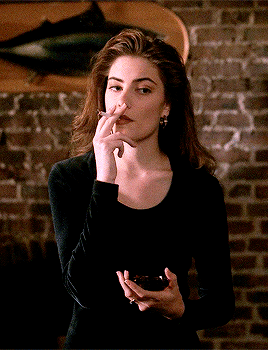
🐇 mädchen amick: jyeshta surya
🦉 recall from the earlier paragraphs, jyeshta is considered to be linked to the goddess lakshmi (the sister of jysheta’s comparative goddess: alakshmi). lakshmi is depicted as sitting on an owl. this owl is why jyeshta is associated with the supernatural owl. owls are said to symbolize knowledge, wisdom, and dread. the owl is also closely linked to the dawn of death and misery. the differences of the spiritual associations of the owl is symbolic of the axis of jyeshta/alakshmi and lakshmi. due to their rare and majestic nature, many cultural myths associate owls with the presence of a higher being, such as guardians, spiritual guides, and vahanas. their ominous hoot is an anamnesis of being lost in a dark forest reeking of danger and the scent of pine. the owl may either be your beacon of light, carrying the auspicious powers of lakshmi into your life, or bringing detrimental, loss and death to your dearest beloved.
🐦 the name of lakshmi’s vahana owl is known as uluka. uluka is considered to be another name for lord indra (the deity ruling jyeshta). the combination of the goddess of wealth (lakshmi) and the king of heaven (indra) personifies the auspicious, wealthy, and powerful spirit linked to the owl. because the owl dwells in the night, it is also a symbol of the darkness of ignorance (avidya). the owl’s aversion towards the daytime is indicative of turning away from the solar path to embrace the feminine forestry of the night. the is why lakshmi is said to guide one to open the eyes to the light of wisdom residing within themselves. she is said to guide you to the goddess saraswati, who is said to rule our knowledge, alphabet, and the tongue (recall jyeshtas penchant for the tongue). uluka becomes lakshmi’s vahana when she blesses wealth and prosperity. the owl asks of lakshmi’s devotees to not be trapped by the illusions of wealth (444), warning against the dangers of arrogance and stressing discipline. when her wealth is used by humans for inauspicious activities, one is said to be blinded, like owl who can longer tolerate the bright rays of surya. it is then uluka embraces the antithesis of the axis and becomes a bird of ill omen flying the goddess of alakshmi around to your door-step, bringing darkness, disgrace, inauspiciousness and misfortune.
🏔 the show “twin peaks” is heavily influenced by the jyeshta nakshatra, as approximately 25% of it’s cast and four directors have prominent jyeshta placements (surya, chandra, lagna, or atmakarala). it centers around a small logging town filled with murder. in this show, nothing is as it seems, intuition is valued, and your dreams guide you. a common phrase in the show is: “the owls are not what they seem”. in the show, there appears to be two paranormal realms, the black lodge and the white lodge. these realms correlate to the lodge spirits, who are unable have physical bodies. because of this, they are limited in the ways they can travel outside the lodges and usually require a host/vessel. while other spirits exist in various mediums, like wood, electricity, and running water.
⛰ the owls are said to be a physical medium of the watchful eyes of the lodge spirits. the owls are theorized to control the entire narrative of the story, invoking harm or bliss. they serve as a barrier and channel between the illusionary twin peaks and the deeply uneasy spiritual lodge realms. in the show, they literally serve as a mask to cover the face of a harmful spirit. thus, the owls are not what they seem. they may channel the deity they please and bring the essence of lakshmi or alakshmi to your door.
♟the owls are reminiscent of the nature of scorpio. scorpio is representative of the eighth house of the zodiac. with kuja being it’s rashi lord, we see a strong amount of strength, energy, achievements and inheritance in the lives of these natives. because scorpio is the watery dusthana, they have a strong intuitive nature when they let their guard down. in twin peaks, you will see many characters try to appear strong when, in reality, they are some of the weakest and sensitive characters in the whole show. an example of this is shelly (played by jyeshta native mädchen amick). shelly married an abusive man who expected her to only do domestic chores and be subservient. she tries to appear fine and cover the bruises to protect her other lover, but quickly her illusion is shattered. she becomes lost and scared, only to regain her confidence via her other partner. another possible jyeshta co-star, kimmy robertson (who played lucy), struggles with handling her romantic endeavors and is quite stubborn. once she feels she has met the right partner, her stubborn nature corrodes like a boulder chipping away from a cliff, only to reveal a sweet, pleasant waterfall of love. due to the scorpio rashi’s strong intuition, they generally have fixed ideas and tend to relentlessly follow them out of faith in their perception of the unknown. the deputy chief (played by jyeshta buddha atmakaraka native michael horse) is known for following his intuition and, due to this, he eventually ends up saving the lives of many others. scorpios also tend to value a small, close-knit friend group. we see the small town of twin peaks frequently coming together to help each other in need.
🌟 the eighth house is associated with the unveiling of deep secrets. this is why scorpios feel the immense need to get to the state of raw purity (the cosmic egg) to examine the situation in it’s purest form. throughout the entire series, mysteries are repeatedly being discovered and solved. however, these mysteries do not solely require the analytical mind. they also require the help and guidance of outside and unexplainable sources. in order to solve these mysteries, you must channel the nature of the owl to evaluate both sides. the eighth house/scorpio is also said to rule the genitals, whereas, kuja is said to heavily influence the sexual organs. in the entire show, sexual pursuits, pr*stitution, and kundalini energy is rampant. sexual energy abundance and accumulation is the cause of adoration. this is why we see jyeshta natives, like the fictional character holli would, nicki minaj, or fka twigs, exciting the sexual passion within others and enticing the masses with their trickster nature. you will often notice many jyeshta (and other buddha/kuja natives) natives create a great deal of sexualized content to express their untamable and playful skill. they embody indra in combat and wield their bodies like a cosmic sword, exciting the virility in others with their sharp nature. however, jyeshta natives do not care for pleasing the average partner, they wish to dominate them with their seemingly submissive nature. they thrive in an environment of underestimation and want you to assume they are a surreal illusion. much like the ashlesha nakshatra, jyeshtas are either tamed or dominated, but—more frequently—they are the one’s to dominate, as many people do not know to handle such icy, hot energy and are simply in mere awe of their beauty. this issue with knowing how to work along with jyeshtas and rise to their level is something many people struggle with. instead of wishing to see the jyeshta flourish and glow with passion, they will try to drag them down to their own low vibrational level, reminding jyeshtas of their original gandanta point of sorrow.

🐇 princess nokia: jyeshta chandra
💧water and, thus, the color blue holds great power in the lives of jyeshta. the jyeshta goddess herself was adorned with blue-black garments and is said to hold a blue lotus in her right hand. the color blue is said to be associated with shani and the lotus is representative of the vimshottari evolution of shani. the many shades of blue are reminiscent of the azure of a clear sky. shani is the planet of hard work, determination, and respect. if you honor shani, you will likely be at the zenith of life. shani is debilitated in the bharani nakshatra (representative of the famale yoni). bhumi is said to mount the elephant and jyeshta’s nature is often compared to the elephant (the yoni of bharani). we see water personifying their internal struggle of diligence and sexuality. the element of water itself flows and crashes with it’s feminine luster. it denotes cleansing, rebirth, and vital energy. the practice of swimming and watery movement is said to excite the feminine spirit and remove all negative energies that encompass the individual. think of how you take a refreshing bath or wash your face. the act of cleansing and the alignment with the water element is energizing and refreshing. recall the christian practice of baptism. baptism is said to be a christian rite of admission. it uses the rejuvenating power of sprinkling, pouring, or entrenching the devotee with water to wash away their sins. this behavior parallels to the churning of the cosmic ocean to produce the elixir of youth, as christians believe baptism saves the youth/innocence of your soul.
🌿 jyeshtas are often forced to grow up quite early in their lives. the often harsh and toxic environments they are surrounded by do not yield a balanced and cleansed individual. it is destined for them to put on a mask or illusion cope with this (recall the demonic spirit who used the owl mask in “twin peaks”). it allows them to feel protected, as how harnessing their sexuality brings them great power. but deep down, they are innocent and youthful spirits. paralleling the goddesses jyeshta and alakshmi who lived lives of great strife but had a kind soul. their aversions to auspiciousness is something they could not control. it was their destiny. the life of jyeshtas are said to be incredibly karmic and destined. they cannot control the terrible and harsh energies of those who may come and go in their lives, but they can choose to walk through the smoky abyss or deep, cleansing waters to see if there is light on the other side of life.

🐇 brigitte bardot (left): jyeshta lagna
🐇 jane birkin (right): jyeshta surya
🚬 it is not uncommon to see jyeshta natives enjoying a good cigarette or cigar. as i once discussed in my magha exploration, natives of the gandanta points enjoy the symbolism and release smoke brings. this is because gandanta points are where the water and fire elements meet and cross. water is symbolic of the divine feminine (4H, 8H, 12H) and fire is symbolic of the divine masculine (1H, 5H, 9H). these elements are complete opposites. when water and fire collide, the water subdues the fire and we are only left with smoke. in the song “smoke on water” by deep purple (who has five members with prominent jyeshta placements), we see the nature of this smoky elemental intermingling under the co-rulership of ketu. the promiscuity of water and purification of fire combines and forms the infinite knot. ketu is the south node, representing our past lives and karma. whereas, buddha is the planet of awakening the discriminating intellect between benefic and malefic actions, essentially good and evil. the harsh, polar forces of water and fire (rashi elements) coupled with past lives and karma (ketu) and knowledge (buddha), create this need for escapism. the need for stimulation to calm the ever-present sense of anxiety or physical ailments gandanta natives are prone to. the use of cigars, cigarettes, or cylinder-shaped products of other smoky varieties (🌿) as a way to ease their anxious nature. as the dusthana houses are uneasy, ketu is unstable, and buddha plays tricks on the mind.
🌫 the cylinder shape of these smoky, stress-relieving products is symbolic of yang energy (the phallus). while this may sound odd, the intoxicating (yin) energy of tobacco and the yang shape of these products creates the perfect balance of water and fire to attract these natives. this is reminiscent of the nineveh cylinder. this cylinder is designed to be a message to the universal one and directs the eyes are set upon it. it is only the eyes that contain an energetic consciousness who will be able to understand the cylinder’s message. you must be able to feel and think to be integrated into the powers of the cylinder and hence the have the power to ascend. one’s energetic signature then changes and only then may the individual have the ability to receive it’s messages or symbols. this acts as a cosmic safety valve to prevent the duality of the lower dimensional worlds from contaminating the higher dimensions that reside in cosmic unity (indra). it represents achieving the human ability to go within your self and untie the knot/noose of tripura sundari within to balance one’s intention, focus and willpower. the symbol of latter is an upward or downward pointed triangle. this triangular figure is symbolic of completion, the three worlds tripura sundari transcends. the journey for jyeshtas is long and hard, filled with fire and water, smoke and mirrors, and lightness and darkness. the cylinder of nineveh invites jyeshtas to walk through the smoky abyss, through the yang passage of the cylinder to untie their inner knot of restriction to be finally free from the harsh realities of this world.

🐇 ‘holli would’ as played by jyeshta surya kim basinger in “cool world”
💋 as always, i am open to any constructive criticism! i tried to touch on the deities’ involvement in the appearances, manifestations, and symbolism of jyeshta. to be quite frank, studying the story of jyeshta brought me to tears. it’s unfair the amount of harm and difficulty they experience in their lifetimes, but their determination and wit pulls them through. studying these many deities, symbolism, cultures, and religions for this post has been so honoring and humbling. as i was making this post, a bunny approached my window and i do not live in an area where rabbits are common. i just thought that was a lovely sign, i’d be a fool to think this is merely a coincidence. if you are looking for more information about jyeshta, get to know the overrulers and supreme deities of kuja, bhumi (the earth goddess) and skanda (the war god), and buddha, vishnu (the maintainer) and narayana (the cosmic person). also—and i cannot stress this enough—familiarize yourself with the deity of this nakshatra: indra. if any of my placements or information are incorrect please feel free to let me know! also, i am fully aware of the origins of vedic astrology and if i was in anyway disrespectful to hindu culture, i will take down this post immediately. i am incredibly honored to know such lovely vedic astrology enthusiasts. you all mean so much to me xx
**all of these placements were found using astrotheme/.com and/or astro-charts/.com. it is important to note that some chandra (moon) placements may be off by up to 6 degrees and lagnas (risings) as well, due to the fact that many websites do not have 100% accurate birth times for the given celebrities.
**i take absolutely no credit for the invention of vedic astrology-based appearance profiles. please watch claire nakti on youtube or look into @/cn0bles, @/lovejustlied, @/dh4nishta, and @/vanillemercure on twitter for more in-depth analysis on vedic astrology xx
#vedicastrology#astrology#moon#nakshatras#budha#rahu ketu#mercury planet#scorpio#scorpio aesthetic#scorpio moon#jyestha#mars planet
613 notes
·
View notes
Photo

Movies I watched this week - 37
Robert Bresson’s philosophical Pickpocket, inspired both by Raskolnikov from ‘Crime and Punishment’ and by Camus ‘The Stranger’. And in turn it inspired Paul Schrader, the other conflicted Christian filmmaker. Austere and mysterious.
✴️
And so 3 by Paul Schrader (all starring Willem Dafoe):
✳️✳️✳️ The Card Counter, Schrader’s new masterpiece. A tortured soul seeking redemption in a ‘ballet of violence’, just like in many of his previous films. The part of the torture program in Abu Ghraib is tailored a bit too close to the real Mitchell / Jessen psychopaths. But OK. 8+ / 10
✳️✳️✳️ Affliction, a completely different set up: Nick Nolte’s turns into his drunk, abusive father in a cold New Hampshire winter. A sad story of how a family curse is passed through generations, without redemption. His poor daughter...
✳️✳️✳️ Auto Focus, atypical light Schrader pastiche about murdered actor Bob Crane’s friendship with John Henry Carpenter. Crane’s sexual obsession must have been the appeal to Schrader. Told as an uncanny pastel joke, that hides a dark and disturbed core.
✴️
First watch: Sergei Parajanov’s homoerotic The Color of Pomegranates (1969), a stunning visual poem of nearly-ethnographic Armenian tableaux. Reminds me of Jodorowsky. The inspiration to Tarsem’s music video for R.E.M.'s ‘Losing My Religion’.
(Photo above)
✴️
In 1965-66 American-backed anti-communist militias tortured and executed up to a million ‘enemies of the state’ in mass killings in Indonesia.
The Act of Killing is a 2012 terrifying Danish documentary where a group of these now-old death-squad leaders recreate and reenact their actions from that time.
Indonesia, it seems, is not a very enlightened country.
The most original film of the week.
✴️
Sofia Coppola’s Somewhere, a privileged father-daughter drama. A new superstar actor lives at the Chateau Marmont, and spends some time with his 11 year old daughter. Contemplative with Coppola’s usual slow, long shots style, but pointless and bland. The parent-daughter part was OK, but the Hollywood-fame portion was uninteresting. Even the hot pole-dancing Playboy twins were not exiting.
✴️
“Ah, the smell of goulash!”
First watch: Lubitsch’s That uncertain feeling, 1941 erotic comedy, full of sexual innuendos and double entendres that the Hays Code didn’t catch.
“Phooy!”
✴️
Truffaut’s 4th film, The Soft Skin, with Catherine Deneuve’s dead sister, Françoise Dorléac. A married man falls in love with a young stewardess. After 3 New Wave originals, this was derided as a “bourgeois melodrama” and was a commercial failure.
Always with Georges Delerue’s music.
✴️
Orson Welles’s existentialist The Trial, based on Kafka’s novel. Starring unconvincing and too young-looking Anthony Perkins as a man accused of a crime he didn’t commit and which he doesn’t understand. Also with Jeanne Moreau. One literary bad dream with lots of absurdist going-ons. It all hinges on K’s feelings of guilt.
✴️
A different kind of a bad dream, the ultimate Orange County, CA very black “comedy” Very Bad Things. Like ‘The Hangover’, but worst-case-scenario bad.
✴️
Recommended by my mom:
The Hundred Foot Journey, a predictable restaurant-porn about the second Michelin star in a “little, quaint French village”. By Lasse Hallström, who specializes in this kind of international fairy tales, and Oprah Winfrey. Commercial clichés and stereotypical tropes. 2/10
✴️
"You're a cookie full of arsenic"...
Sweet Smell of Success - 2 slimy operators, “publicist” Tony Curtis and influential gossip columnist Burt Lancaster unethically conspire to destroy a jazz musician in a gritty Manhattan Noir. Another sizzling Ernest Lehman manuscript.
✴️
Barry Levinson paid tribute to ‘Sweet Smell of Success’ in his debut feature Diner, with one of the kids wandering around saying nothing but lines from the film. So I watched it again. What a wonderful piece of triple nostalgia (1959-1982-2021). Perfect in every sense, especially when showing unexpected sides to each character: Boogie doing hair, Billy playing the piano, Eddie dancing at the strip club.
“You’re gonna finish this?”
Best film of the week!
✴️
Best Sellers, the new Michael Caine vehicle. He’s a cranky, washed-up, bitter author, who’s drunk the whole time. His orange cat is the only other good thing in this lame “comedy”. With a horrible Aubrey Plaza. 2/10
✴️
2 X Vanya’s:
✳️✳️✳️ The 2020 British stage adaptation of Chekhov’s Uncle Vanya, with Toby Jones as Vanya, and Roger Allam as the professor. It deals with purposeful life, beauty, money, and one of the first discussions of ecological problems in world literature.
✳️✳️✳️ I’m glad I waited to watch Louis Malle’s last film, Vanya on 42nd Street, after the BBC version. Even though it was filmed 26 years earlier, it was much more contemporary. The combined talents of David Mamet, Andre Gregory and Malle modernized the play into a brilliant whole. Wallace Shawn was great! 8/10
✴️
Chaplin’s delightful 1922 Pay Day, first (?) tramp film where he has a (nasty, harping) wife.
✴️
U Turn, Oliver Stone’s sadistic, disgusting and pointless mess. Sean Penn is a permanently unlucky schmuck, who “pulls up to a tiny no place in the Arizona desert”. Bad Tarantino clone.
Thanks a lot for the recommendation, Sammy! 1/10
✴️
Because Norm Macdonald died today, I watched his Dirty Work. A grave mistake! His dry humor was good for a few sardonic one liners, but not for this stupid, sophomoric loser. 0/10
✴️
42 enjoyable minutes of a crash course on fromage, how to cut it and how to serve it.
- - - - -
(My complete movie list is here)
4 notes
·
View notes
Text
FOMA 34: Heritage of the Productive Landscape
The lower Segura river valley is located on an old marine sedimentary basin because 2.000 years ago the Mediterranean Sea flooded much of what is now known as the Vega Baja region in South East Spain.
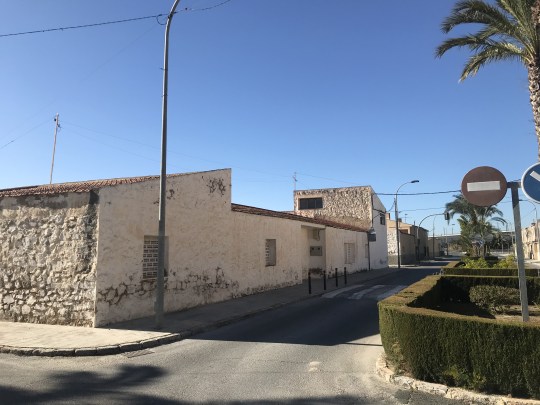
Street profile in San Isidro. | Photo © Carolina Gomez
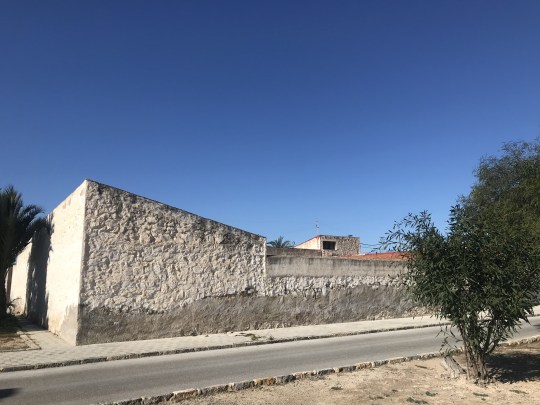
Residential unit and its back courtyard. | Photo © Carolina Gomez
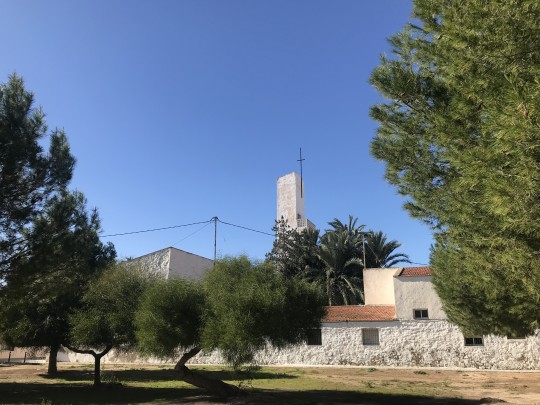
Mix of nature and stone white walls in El Realengo. | Photo © Carolina Gomez
This sedimentary layer is non permeable, so although it rains very seldom (aprox.290,0 mm/year), terrain keeps this water. Combining this particularity with local climate conditions, and its ancient irrigation system, the countryside is very fertile, one of the largest fresh-exporters in Spain.
But lets get back to 1950s in Vega Baja. After the devastation of the Spanish civil war there was the deep need to promote economy, education, and social conditions. National Institute of Rural Development and Colonization was the administrative entity that was established by the Ministry of Agriculture in order to repopulate certain areas of Spain. The Institute acquired land, which it transferred to the villagers under different conditions.
In this scenario Architect Fernandez del Amo, from the institute was developing village planning for Realengo and San Isidro, among others. The objective was to increase agricultural production, meanwhile providing education and housing for workers.

Palm trees field overlays with public buildings. | Photo © Carolina Gomez
Housing units build the plot facade and contain a patio and backyard for planting and farming uses. Following the experimental nature of Fernandez del Amo, each rural development sets main roads and public buildings in the terrain differently. We can find this research also in the way of treating and including landscape and the combination of urban and nature.

The church in El Realengo. | Photo © Carolina Gomez
Making the most of existing resources is the DNA of the place. The architect was working always with local materials and local knowledge, using masonry construction techniques of each area, collaborating with local expertise like cabinet makers, carpenters, mural artists, giving a value to austerity through eliminating superfluous and presenting naked essential architecture, where lines and volumes express abstractly and still follow efficiency and economy.
Urban spaces and the residential complex are all in all, in a good state. Although we miss elements like irrigation system connected with pedestrian paths and other landscape elements, which will allow a complete understanding of the place. Architectural elements as doors, windows, railings, has not always been respected in most of renovation works, that have lead to kitsch solutions.
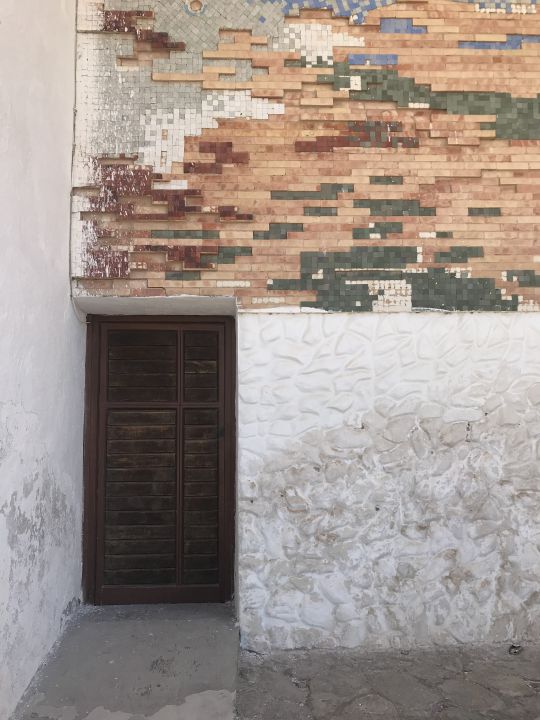
Textures from local masonry, carpentry, mural. | Photo © Carolina Gomez
In an outstanding time, where our way of living and building was evolving, architects like Miguel Fisac, Alejandro De la Sota, Jose Antonio Coderch, and Jose Luis Fernandez del Amo where working with reinterpretation of popular architecture against monumentalism. But how to name it popular architecture, when each step and detail is intellectually extraordinary tailored?
Nowadays, this more authentic postwar architecture concerned with social welfare and austerity connects with climate committed architecture, we are in research. Since 2004, when Rem Koolhaas proclaimed at Columbia University that “preservation is overtaking us”, interest in heritage has grown exponentially. Constructed heritage has expanded to constructed and natural landscapes, infrastructures, and even no-ones lands or in-between spaces. Summing up with climate emergency, we are in the inflexion point where we understand if we are not producing heritage, we are producing waste.

Singular building in San Isidoro. | Photo © Carolina Gomez
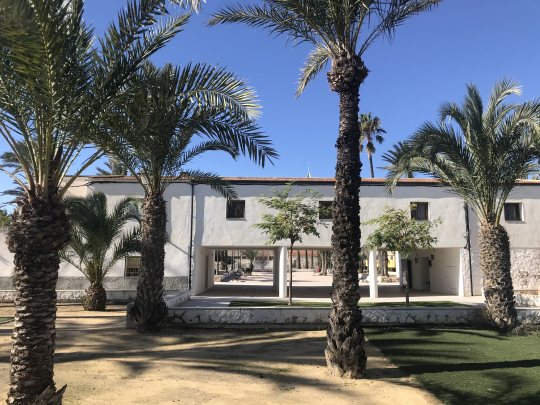
San Isidro main square. | Photo © Carolina Gomez
Lets move to the 60`s in Vega Baja. People were looking for the first time at the coastal line as an attractive place to live in and as a productive landscape (before luxury housing were build in inner fertile areas hiding from the wind and salty atmosphere). Franco's dictatorship exploited sun and beach tourism in Spain through the declaration of National Tourist Interest Areas and Spain was characterized by economic growth.

Dehesa de Campoamor combines different typologies and mix with the existing nature. | Photo © Carolina Gomez
Dehesa de Campoamor was planned as a National Tourist Interest Area by Antonio Orts. It is placed in a singular coastal reddish slope in a landscape of Monte Bajo and Pinada. The project addresses the new demand for summer leisure, experimenting to join functionalist urban planning of the modern movement with the existing nature of the area.
The masterplan research mix of situations: different densities, horizontal and vertical residential typologies and morphologies, radio centric city and garden city, ending up in a rich solution. Masterplan preserves higher environmental quality thanks to the balance between the average density of building and respect for the natural landscape. Lively hood is assured by zoning its main uses and public buildings, especially those related to tourism: yacht club, hotels, restaurants, disco and cinema. We find interesting singular elements as the modern-historical center, the summer cinema, or the yacht Club. Because of all that Dehesa de Campoamor is listed in Docomomo-Ibérico.

Entrance to Dehesa de Campoamor Yacht Club. | Photo © Carolina Gomez

Dehesa de Campoamor Yacht Club from the beach. | Photo © Carolina Gomez
The Yacht Club was developed by Fernández del Amo. The building organises in the steep coastal line based in a hexagonal structure. The architect was familiar working with this shape as he was leading Spanish Brussels Pavillion renovation works with architects Corrales and Vazquez Molezún. The project extract the roots of the popular, attracts and hold the interest in figurative poetics. The building is in a good state and keeps it former uses structure.
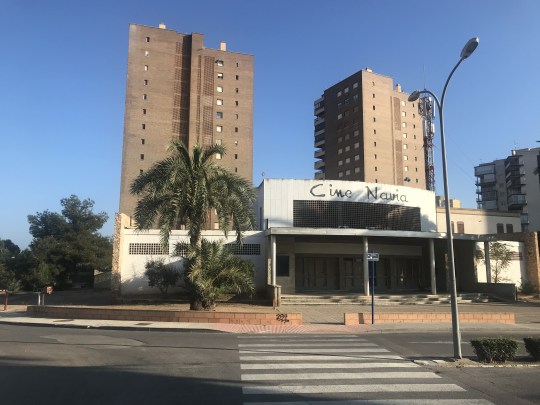
Navia Cinema in Dehesa de Campoamor. | Photo © Carolina Gomez
At the moment of writing this, Countryside, The Future exhibit by Rem Koolhaas and Samir Bantal opens at the Solomon R. Guggenheim Museum in New York. The project presents investigations about the 98% of the earth that is not occupied by cities. Leisure, large scale planning, climate change, migration, ecosystems, preservation. Its time for architects as enablers of the future, to expand their field of vision to countryside, landscape and intermediate spaces.
---
#FOMA 34: Carolina Gómez

Carolina Gómez is an experienced research based strategic urban planner and all-round designer, focusing on landscape, heritage and climate responsive sustainable solutions. Educated as an architect, Carolina has worked independently in urban and landscape design projects of varying scales through Russia, Egypt, and Europe, spanning the fields of analysis, temporary projects, concept visionary design and city transformation projects.
In 2018 she founded Carolina Gómez | Architecture & Environmental Planning in Vega Baja-Spain, where she combines local knowledge with her international experience and strives to build meaningful, context-specific spaces for active and healthy lifestyles, social interaction, sustainable living and exponential technologies.
3 notes
·
View notes
Text

#finishedbooks The Possum That Didn't/ The Bear That Wasn't by Frank Tashlin. Put these two together because well... they are children's books. Tashlin perhaps is more known for his technicolor Jerry Lewis and Dean Martin comedies (they don't hold up well, but beautiful reds!). So it was interesting happening on his children's books that serve beautifully as allegorical criticisms of American consumer culture. Take for instance the story of The Possum that Didn't, it is about a happy possum that hangs upside down in a tree and one day people see him and because they can only see from their perspective mistake his smile for a frown because he is upside down. They take him through the city showing him their clubs and movies, but he sees the world and doesn't like it because everyone is just sad and empty...he becomes unhappy. The people congratulate themselves because they can only see things their way and abandon him. Isn't this a perfect parable? The Bear that Wasn't was made into a beautifully absurd animated film also directed by Tashlin about a bear who hibernates and wakes up to find himself in a factory that tore down his world. The foreman yells at him to get to back to work to which the bear responds, "but I am a bear". The foreman calls him a silly man in a fur coat who needs a shave and takes him through the beaurcratic chain of bosses that all accuse him of the same. He finally gives up and conforms, working everyday in the factory...that is until it is closed and he is laid off. What I found interesting was that Tashlin could only say in children's books what he couldn't in Hollywood films. While playful it is easier to inflict truths and I love not only the creative challenge but just the possibilities in children's stories. Me and Simon Debeor are currently working on a children's book I wrote about class structures using basic shapes as a metaphor and I am also half way through a photo project using a Looney Toons motif with more austere surrealism. But overall think it was that classic 1920s Soviet constructivist children's book by El Lissitzky, Two Squares that showed me the artistic potential in children's stories...which makes sense as artists are really just trying to get back to a child's imagination anyway...
1 note
·
View note
Link

This undated photo released by Mexico's National Anthropology and History Institute (INAH) shows an ancient Maya pictographic text that has been judged authentic by scholars in Mexico City. (INAH via the Associated Press)
Fifty-four years after it was sold by looters, an ancient Maya pictographic text was judged authentic by scholars Thursday.
Mexico's National Institute of History and Anthropology said the calendar-style text was made between 1021 and 1154 A.D. and is the oldest known pre-Hispanic document.
The 10 surviving pages of the tree-bark folding "book" will now be known as the Mexico Maya Codex. It had been known as the Grolier Codex. It may have originally had 20 pages, but some were lost after centuries in a cave in southern Chiapas state.

A worker inspects the an ancient Maya pictographic text in Mexico City. The INAH says the text was made between 1021 and 1154 A.D., is the oldest known pre-Hispanic text, and will now be known as the 'Mexico Maya Codex.' (INAH via Associated Press)
It contains a series of observations and predictions related to the astral movement of Venus. Mayan texts are written in a series of syllabic glyphs, in which a stylized painted figure often stands for a syllable.
A Mexican collector bought it in 1964, and it was first exhibited at the Grolier Club in New York in 1971.
Collector Josue Saenz returned the book to Mexican authorities in 1974.
The fact that it was looted and had a simpler design than other surviving texts had led some to doubt its authenticity.
"Its style differs from other Maya codex that are known and proven authentic," the institute said in a statement. About three other later Maya "books" survived an attempt by Spanish conquerors to destroy Mayan artifacts in the 1500s.
Chemical tests
But the institute said Thursday that because the book was written so early, it had been created in an era of relative poverty compared to the other works. It said a series of chemical tests proved the authenticity of the pages and the pre-Hispanic inks used to write it.

Scroll to see the 10 surviving pages of the tree-bark folding 'book.' It may have originally had 20 pages, but some were lost after centuries in a cave in southern Chiapas state. (INAH via Associated Press)
While previous studies had supported the authenticity of the text, it was the end of decades of doubts for the book.
"For a long time, critics of the codex said the style wasn't Mayan and that it was 'the ugliest' of them in terms of figures and colour," said institute researcher Sofia Martinez del Campo. "But the austerity of the work is explained by its epoch, when things are scarce one uses what one has at hand."
464 notes
·
View notes
Text
The Ultimate Guide to Backpacking Nepal On A Budget: Backpacking Itinerary
Backpacking through Nepal is something different then you will ever experience. Trekking is by far the most popular activity in Nepal and this is the reason why every year thousands of tourist enter Nepal during the high seasons. There are countless number of treks that Nepal has to offer according to your need, time or budget. Nepal is especially known from the mighty Mount Everest, and a lot of people travel from all over the world to capture a glimpse of the world’s tallest peak. However, Everest Base Camp trekking is just a small fraction of beautiful paradise that Nepal is. The country has lot more to offer whether it be high Himalayas, beautiful monasteries or diverse culture that reside under a single roof. You aIso have the option of taking helicopter rides to Everest via Everest Base Camp Helicopter Tour if you want to see the Mt Everest but don’t have that kind of time and dedication. You will find most unique teahouses, and friendly locals you will come across anywhere on the planet. I loved visiting Nepal and I loved learning about culture and language. Whether you’re exploring the country in your 20s or later in life, you’ll want to make the most of this incredible once in a lifetime adventure.
The itinerary that I have listed out below is designed approximately for five to six weeks but you can easily cut out some destinations that don’t interest you or extending your time in places you most want to see.
Set a Budget for Yourself
First things first, a lot of my budget went to pre-trip necessities such as trekking gears since hiking is the main reasons you are visiting Nepal. You’re going to want excellent footwear and hiking boots if you are planning on waking 6 to 7 hours a day and dressing conservatively is the best option to avoid unwanted attention.
Before leaving for my first stop in Kathmandu which is the capital city of Nepal, I did a lot of research — lots of it — because that’s how you bring costs down. I planned my lodging, transportation, food, museum tickets, everything for a day and decided to stick to my day’s budget. It’s not too early to think about where you want to go and start planning earlier. I even spent less than I thought I would.
The Best of Backpacking Nepal Routes
1. Explore Kathmandu Valley: You wouldn’t want to miss out on Sightseeing in Kathmandu valley. There are many beautiful old cities to explore in the valley with ancient temples and Durbar squares before you start trekking in Nepal. I visited the Swayambhunath Stupa. This Temple is also known as Monkey Temple which is considered to be self-made Stupa. Then my next visit was Kathmandu Durbar Square where there was Goddess Kumari then living goddess and number of temples. Then we went on to Patan Durbar Square where we can observe mediaeval architecture along with live history and culture. I also got to see all those monuments represent medieval, history, culture and architecture. Must say Kathmandu valley is really rich in its culture and heritage. Apart from this I got to explore Thamel the most popular destination for tourists visiting Nepal, a place most backpackers make a beeline for, the moment they land in Kathmandu and I must say it is the most happening place in Kathmandu with all the hotels, restaurants, clubs and bars.
2. Explore Pokhara, Track Rhinos at Chitwan National Park and Sightseeing at Lumbini the birthplace of Gautam Buddha: Pokhara is one of the main tourist destination of the country. Surrounded by two of the highest mountain in the world Mt. Annapurna and Dhaulagiri, the Pokhara city, is also the gateway to the most beautiful multi days trekking trail in the world.
The next step is Jungle Safari in Chitwan, my absolute favorite part of our Kathmandu Pokhara Chitwan Tour. This national park is an excellent place for jungle activities like Elephant safari, Bird watching, Canoeing etc. You might also be interested in visiting the elephant breeding center there. In the evening, you can enjoy the delicious cuisine at your resort along with the cultural dance program performed by the Tharu community of this place.
We visited Lumbini where Lord Buddha was born, we strolled through parks where he spent his childhood, walked through the upscale neighborhood exploring the place and surrounding places, took many photos of famous sites. Lumbini is popular for Buddhist and Hindu pilgrimage travelers.
3. Trek around Annapurna Region: For many people who come to experience the incredible mountains of the Himalayas, Annapurna Himalayas is their favorite region to trek among all the trekking places that Nepal encapsulates. This demanding trek consists of some of Nepal’s finest mountains. Located west of Kathmandu, this range contains some of the finest scenery in all of Nepal. With Annapurna I rising to a height of 8,061 meters, it is the 10th highest mountain in the world. This region is home to some incredible treks, like the Annapurna Circuit, Annapurna Base Camp trek and Poon Hill, you will have tonnes of opportunities for hiking adventures. We encountered many rivers and lakes along the way so you might as well pack some fishing gears if you’re interested in those stuff. The key attractions of this region are the insight to archaic Gurung as well as Thakali settlement, astounding landscapes, soaring climatic mountains and lush marshland alongside encounter of exclusive wildlife.
4. Upper Mustang Trek: The Mustang trek has been on my bucket list ever since I arrived in Nepal. This beautiful place is full of mysterious and enchanting landscapes. I’m fascinated by the deeply-rooted Tibetan culture and practice of Buddhism in this region. I came to know that it is the last forbidden Kingdom, which is situated in the isolated Himalaya desert behind the stunning mountains Annapurna and Dhaulagiri. A hidden paradise, Upper Mustang is fused with mystique valleys, beautiful trans-Himalaya landscapes, ancients Tibetan Buddhist shrines, prayers walls, stupas, century old monasteries and many more. The trek to Upper Mustang is possibly the most unique of all treks in Nepal due to its harsh landscapes, dry, bare mountains with a covering of fresh snow on the top.
5. Everest Region Trek: Everest region Trek in Nepal is the enthralling legendary walking route. Mount Everest is one of the most amazing natural sites you can see anywhere in the world, this almighty mountain lie in the Everest region. Walking all the way of trekking routes is long duration and needs physically fitness. So, helicopter ride to Everest is the best option to be at the high elevation in short period of time and enjoy the view of Mt Everest in no time. Every year thousands of trekkers trek on this trail and access to Everest’s basecamp is becoming a whole lot easier, which now attracts more people than ever. No matter which trail you follow though, you will soon be immersed in the austere beauty of this awe inspiring trekking region. It’s an incredible experience, a top highlight of my life. I think it’s a lifetime of global adventures.
6. Helicopter Rides: Almost everyone has that desire to conquer awesome vistas of snow-capped mountain, and panoramic landscapes. Thus, Helicopter tour is designed for travelers with tight schedules, who has no time for long 20 days trek but still can enjoy one of the best travel destinations in the world.
Everest Base Camp Heli tour starts from Kathmandu, flying east from Kathmandu towards the beautiful Sherpa village. With the helicopter facilities to the Everest region, you’ll get to have the coolest trip that you can imagine and this is specially for the ones who due to some reasons cannot go to Everest base camp via trekking but you still want to explore the Himalayas then Everest Base Camp Helicopter tour is the best way of exploring the world's highest peak.
1 note
·
View note
Text
New Beat
Miraculous Ladybug Fanfic (Companion Story to Worlds Not Our Own, Friendship Fic)
Chapters
In The Shadows | Chp 1 | Chp 2 | Chp 3 | Chp 4 | Chp 5 | Chp 6 | Chp 7 | Chp 8 | Chp 9 | Epilogue | Timeline
Chapter Four: Freedom (AO3 Link)

Chapter Snapshot
Chat Noir's face split into another grin. It seemed to be an infectious reaction. "Nah, I don't own the color. What'd you do for her?" he asked.
Black Eagle slapped Chat on the back, slightly pushing him towards the intersection. "Come see." He led him out into the street to the green storefront with the curtains, and Black Eagle raised his eyebrows at the name of it but didn't comment on it. Instead, he pointed just inside the window. Chat peeked around Eagle's shoulder and could see the red-haired girl on a little stage, several people in folding chairs in front of her--it looked like she was reciting something, although he couldn't hear her from outside.
"It's a poetry club," Eagle said, tilting his head as he watched her with golden brown eyes. "Had a little bout of nerves. Just needed a confidence boost, is all." He stood up straight, brushing his hands off at a job well done. "Doesn't look like she needs me anymore, though. Got that shit on lock."
Chat Noir stepped back from the window, turning to the man next to him. If Marinette had known there was some other hero out and around Paris, she definitely would have told him about it--and since she hadn't, that meant this was something that only he knew about.

Adrien sat on his mattress, staring at his mother's photography. She didn't have a very discerning eye--she took pictures of anything and everything--but the framing was always interesting, and it was nice to see what she thought was worthy of her notice. One was a close-up picture of Amélie, just a profile of her nose and mouth, her platinum hair a curtain behind her face. She had a foxy smile on her face, one he knew better than he knew his own, because it was one of the things she and Félix shared. There was another, just a picture of a hole in a leaf, the slightly brown edges crisp in the lens of her camera where the rest of the leaf was spring green and bright. The last one he had pulled out was one of Nathalie's reflection in a mirror. He could see his mother laughing in the background while the more austere woman looked horrified at being caught with her hair down in an oversized plain T-shirt.
Adrien grabbed all three and pinned them up on his wall with the photo hanger he bought at IKEA, and it felt like a fresh start, even though he moved out weeks ago. "What do you think?" he asked Plagg, turning to him with a proud lilt on his lips.
Plagg came up to the wall and returned to the bed to shuffle through the rest with his paws. "Very good, I'm sure, but I think you missed the best of the bunch," he said, pushing everything away except for the picture he wanted to look at.
Adrien smirked, grabbing it off the bed. "Why am I not surprised? I think you need to branch out some, you know--it's good for you." Adrien pinned up the baby picture of him and Félix regardless. The two of them throwing fistfuls of cut-up spaghetti at each other was fuzzy in the image; the real focus was a wedge of cheese in the foreground.
"Doing what you like is also good for you," Plagg said defensively, whiskers up and proud.
"I'm still working on that, I guess."
"That's why you have me to help you along," the little black cat said, landing on his shoulder.
Adrien gave him a scratch behind the ears. "Should we get going, then?"
It was rare that Plagg looked eager to transform when there wasn't any trouble afoot and he was in a lazy mood (which was often), but tonight it was clear just how excited he was. Not that he'd say it out loud, but Adrien could see it in his eyes, green and light and mischievous.
Kam wasn't home, so he didn't even have to worry about anyone seeing or hearing him transform, and in the blink of an eye, he was back in black and slinking out the window. Single and ready to mingle, he thought to himself with a grin, launching himself from his windowsill and flipping (just because he could) before he extended his staff and shot into the air. Becoming Chat Noir again felt good--he couldn't deny that. There had always been a distinct sense of confidence when he was a superhero, because it felt like freedom. He could be anything, anyone, and when he was Chat Noir, he felt as real to himself as he could get.
But that had been before. These days, being Chat Noir instantly brought back memories of fighting his father.
Even though the nightmare for Paris was over, it was still rampant in his head; every fight, every harsh word...every thought that he couldn't imagine who would be hateful enough to cause so much suffering. It was a hell he couldn't escape from, not like everyone else could. Ladybug--Marinette--had her own baggage with being the Guardian, and he'd always hoped she would share it with him. Now he was staring at a suitcase full of his own, and he wasn't sure how to carry it around.
One day at a time, Chat Noir reminded himself. He launched through the air onto a rooftop, taking a moment to stare into the bright lights of Paris, the looming Eiffel Tower in the distance, and the hundreds and hundreds of people. He was one of them as much as he wasn't. Miraculouses were given out to make the world better, but as often as he'd saved them, he was starting to think it was really the other way around. He spent so much time recently wondering what his life would be without Ladybug in it that he hadn't stopped to consider what his life would look like if he'd never been given the Miraculous in the first place.
Would he have frozen in that house? Would he have just done whatever his father wanted forever, only rejoicing in the small moments of rebellion or connection he could get?
Chat shook his head, extending his staff again to keep moving, keeping an eye out for any trouble. There wasn't any, but he did help a girl with pigtails and glitter jelly shoes find her mom again, although she'd only been a block away. It was still good to get out and get all the cobwebs out of his head. He was free to do what he wanted. He was free to be who he wanted (it felt a lot like a double-edged sword).
Chat Noir kept moving through the city and soon found himself at a busy cross street. Five-story buildings stood up all around it, shops on the lower levels and apartments with slightly crooked window shutters above them. Narrow streets held lines of parked cars along the dirty sidewalks, plants and benches and cheery, colorful flags lining the storefront windows. One shop was painted a deep green, with yellow velvet curtains pulled back in the windows to reveal a cozy light coming from inside.
He realized, staring at the sign above the front door, that it was named Au Chat Noir--and he felt that same kick of awkwardness in him as when he would see himself modeling on a billboard. Maybe he was being egotistical; it wasn't like his alter ego was all that unique…
A girl inside the shop noticed him, her smile lighting up as she moved toward the window to get a better look at him. Chat Noir waved but kept moving down the street on the rooftops, jumping the gap in the road to the next roof. A few storefronts away was a worn pizzeria with graffiti on the side of the building and several round tables and chairs. Two people were outside, a man and a woman.
Chat perched on the rooftop, staring down below into the darkness--it was bright enough with all the lights that his night vision wasn't kicking in. One of them was a girl, clothed in a baggy yellow sweater, her red hair curly and frizzy all down her back. She worried a piece of paper in her hand, biting her lip and pacing lines in front of the tables.
"There's no way I can do this," she said, more of a cry than anything. "God, this was such a stupid idea--I should have brought a second one just in case--"
"Nah, no way." The man's voice was deep and reassuring. He was sitting at one of the tables, legs sprawled in front of him. "You've got this. You're proud of it, right?"
The girl almost seemed to cave in on herself, but she nodded.
"Then no sweat. I know it's scary, but it came from the heart. Passion resonates with people, and it sounds like you've got plenty of it."
Chat Noir slid a bit to the right, trying to catch a better glimpse of the man talking. He was wearing a long black coat, feathers lining the collar, and on the back was an hourglass shape painted in white. The dark skin of his face was framed around his eyes with a white mask, a sharp yellow stripe along the bottom rim. He stood up, patting his palms on his thighs with a wide smile on his face.
"You just need a little help working up your courage, yeah?"
She nodded ravenously now. "Please. I'm gonna barf. Or pass out. Or, uh, cry--maybe not in that order."
He laughed, a genuinely happy sound. "Alright, we got this," he said, and a brilliant gold feather appeared in the palm of his hand. It floated to her chest, disappearing in a spark and flash, and her lips parted with a little "oh!" when she felt it.
"Better?" he asked.
"Yeah--yeah, I think I've got this." She said, a slow smile spreading on her face--but then she gripped his coat sleeve, panic back on her face. "What if I trip? Does this help me not trip?"
"Uh, it's more of a brain thing than a feet thing. But it's better than alcohol, which is still plan B--"
"Oh my god--"
"Just think you won't trip, and you'll be fine," he said, chuckling. He spun the girl around by her shoulders, her patchwork skirt flowing around her ankles, and started gently pushing her out of the alleyway. "Go get 'em, champ."
Chat watched the girl jump up and down when the man's hands left her back to try to hype herself up, and then she ran-walked down the street, pausing at the same intersection Chat had been overlooking just moments ago.
"So, Paris's top cat hungry, or does Tweety Bird here get off easy tonight?"
Chat Noir nearly jumped out of his skin--the man had been watching him when he was distracted, and now he was smiling up at him with his hands on his hips. Chat grinned back. He wasn't sure who he was, but from the looks of things, he wasn't a bad guy. He took his staff off his back and extended it with a quick flick of his wrist so that he could slide down it into the alleyway.
"Just a specter tonight, but I'll let you know if I get peckish. I've never seen you around," Chat Noir said, landing on his feet lightly.
The man nodded to himself, a smile still on his face. Beneath the jacket, Chat could see his shirt was white, the ends yellow where the white triangle ended. A talon was looped around his neck with a black cord. "Just pulled in a few weeks ago. They called me Black Eagle back home on account of, you know," he spun around, his black coat snapping around his ankles, the edges lined in red triangles. "But I don't want to step on any toes."
Chat Noir's face split into another grin. It seemed to be an infectious reaction. "Nah, I don't own the color. What'd you do for her?" he asked.
Black Eagle slapped Chat on the back, slightly pushing him towards the intersection. "Come see." He led him out into the street to the green storefront with the curtains, and Black Eagle raised his eyebrows at the name of it but didn't comment on it. Instead, he pointed just inside the window. Chat peeked around Eagle's shoulder and could see the red-haired girl on a little stage, several people in folding chairs in front of her--it looked like she was reciting something, although he couldn't hear her from outside.
"It's a poetry club," Eagle said, tilting his head as he watched her with golden brown eyes. "Had a little bout of nerves. Just needed a confidence boost, is all." He stood up straight, brushing his hands off at a job well done. "Doesn't look like she needs me anymore, though. Got that shit on lock."
Chat Noir stepped back from the window, turning to the man next to him. If Marinette had known there was some other hero out and around Paris, she definitely would have told him about it--and since she hadn't, that meant this was something that only he knew about. There was a certain "ah HAH!" thrill to that, but he wasn't looking to rub it in her face, not at all.
...It did feel nice to be on the other end of it for once.
"You want to hang out for a bit?" Chat asked. "I wanted to stay out for another hour or so anyway. I can show you around some."
Black Eagle didn't hesitate, just swept his arm out in front of him towards the rest of the city. "Lead the way, my man."
What started with easy banter and a slow circuit of the seventh arrondissement ended with a race to see who could get to the top of the Eiffel Tower first (because, well, they were dudes, and that's just what you did when you were a guy with superpowers, and there was no threat to fight, Chat supposed). Neither of them got very far up, though, because Eagle spotted a smoothie cart and quickly aborted mission. Fifteen minutes and an orange and blackberry smoothie later, they were dangling their legs over the Arc de Triomphe, watching the cars and scooters and pedestrians as they navigated the spider web of streets beneath them.
"So, where's Red? I was under the impression you two traveled as a pair," Black Eagle said, slurping on the straw poking out of his plastic cup. Chat must've made a face because Eagle didn't give him a chance to answer. "Tch, you too, huh? Shit, these French women will cut you up."
Chat Noir felt his face flush slightly, that same tightness in his throat coming back. "We weren't actually, y'know, together or anything--"
"Yeah, that's why your face was pulling a full-on Tabitha. You twitched so hard you almost fell off just now."
An over-exaggeration, but not by much. "She's got a boyfriend."
"That sucks."
"Yeah." They sat in quiet for a bit longer, a moment of silence for his gone-to-soon love life, until he couldn't take the quiet anymore. "Are you like us? You know, with a Miraculous?"
Black Eagle nodded, mouth full of smoothie.
"We didn't realize there were any other ones out there," Chat said. They'd known about the Snake and Mouse Miraculouses and had assumed someone had them before Luka came to Paris. But maybe there were others, people with miraculouses they'd never heard of.
He shrugged with a devil-may-care smile. "It hasn't left the reservation in a damn long time, tell you that much. I'm half Lakota--my friend, she had it for a while. Passed it off to me when she felt the time was right, and here I am."
He'd never heard of the Lakota, but given the accent of his French, he assumed he had to be from North America. Maybe it was one of the native tribes--that felt like it fit. "There's not a whole lot going on these days, but it's nice to meet you all the same. You should see Ladybug at some point, though. She'd wanna meet you."
"What is this, the mafia?"
Chat laughed. "No, but she's the Guardian of the Miracle Box, where all the other Miraculouses are stored. She likes to know these sorts of things."
"Yeah, sure, man. She gonna cut me up like she did you?"
Chat Noir stood up, wiping the condensation from his smoothie cup off his hands before grabbing it around the top of the lid. "I don't think she could cut anyone up like she did me." He couldn't help the resigned sigh that escaped his lips.
"Funny enough, that doesn't make me feel a whole lot better."
He grinned. "Yeah, me either."
Black Eagle shook his head while he hopped to his feet, that infectious smile still on his face. It seemed like it was permanently stuck there unless something particularly odd happened, but he was all big expressions and laughs, wrapped up in one easy-going guy. Even when he was still, his eyes sparked with life and the simple joy of living it. "I'll see you later then," Eagle said, giving him a punch on the shoulder. "Totally would've won that race, though."
"Forfeiting doesn't give you the right to brag," Chat shouted, his new friend already headed in the opposite direction with a wild cackle.
Job done for the night, Chat Noir stopped by a trash can to dump his cup and then headed back home, feeling much better than he had the day before. It did mean he'd have to call Marinette and let her know what had happened, but maybe that was a good thing. It gave them something to talk about--something that would allow him to get to a new normal around her.
Chat Noir made his way home to his new apartment, keeping his eyes open for the new window that would hopefully become commonplace to him. He almost missed it the first time, but his neighbors had a set of string lights shaped like flamingos around their bedroom window, making it easier to tell which was his, like a flight path at an airport. Chat landed on the thin window sill with a self-assured thud--and then frowned when he heard a second thud coming from the left.
He did a double take when he saw Black Eagle staring right back at him, one leg almost entirely through Kamdyn's bedroom window, his mouth open like he was calculating the odds of it all.
"Uh…"
"Huh."
They stared at each other for a second longer, and Chat swore he could hear a cricket coming from the deserted park beneath their feet. Black Eagle looked around awkwardly, mouth half open with several aborted attempts to justify why he was standing halfway through the apartment window. Finally Eagle sighed, dropping his chin to his chest, but when he looked up, he was smiling again--this time a little bashful. "Want alfredo for dinner?"
Chat nodded, not sure what else to say. "Yeah. That'd be good."
"A'right. I'm cooking--I can't trust you for shit in that kitchen."
"That wasn't all my fault--" Chat started, but Kamdyn was already gone, laughter floating out the window.

Worlds Not Our Own: Chapter Six, You’re Not Him
#New Beat mlb#Nat's Monster in the Box#alternate universe#adrien agreste#original character#just some guys being dudes#some fellas actin goofy
1 note
·
View note